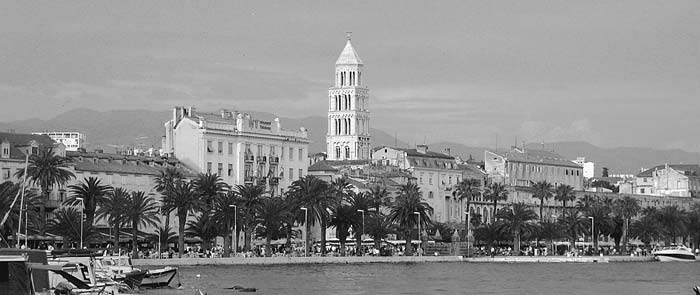
▲▲▲Diocletian’s Palace (Dioklecijanova Palača)
Map: Split Hotels & Restaurants
In Varoš, West of the Old Town
Dubrovnik is the darling of the Dalmatian Coast, but Split (pronounced as it’s spelled) is Croatia’s “second city” (after Zagreb), bustling with 178,000 people. If you’ve been hopping along the coast, landing in urban Split feels like a return to civilization. While most Dalmatian coastal towns seem made for tourists, Split is real and vibrant—a shipbuilding city with ugly sprawl surrounding an atmospheric Old Town, which teems with Croatians living life to the fullest.
Though today’s Split throbs to a modern, youthful beat, its history goes way back—all the way to the Roman Empire. Along with all the trappings of a modern city, Split has some of the best Roman ruins this side of Italy. In the fourth century A.D., the Roman Emperor Diocletian (245-313) wanted to retire in his native Dalmatia, so he built a huge palace here. Eventually, the palace was abandoned. Then locals, fleeing seventh-century Slavic invaders, moved in and made themselves at home, and a medieval town sprouted from the rubble of the old palace. In the 15th century, the Venetians took over the Dalmatian Coast. They developed and fortified Split, slathering the city with a new layer of Gothic-Renaissance architecture.
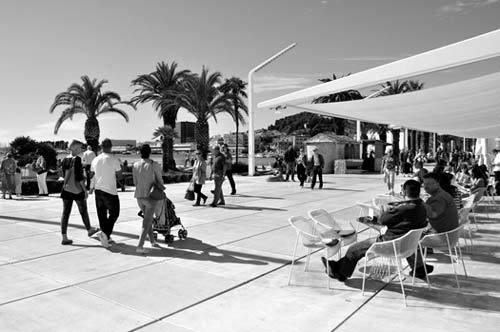
But even as Split grew, the nucleus remained the ruins of Diocletian’s Palace. To this day, 2,000 people live or work inside the former palace walls. A maze of narrow alleys is home to fashionable boutiques and galleries, wonderfully atmospheric cafés, and Roman artifacts around every corner.
Today’s Split has a split personality, as it struggles to decide how it fits into Croatia’s tourist-mecca image: Is it a no-nonsense, metropolitan transit point; an impressive destination in its own right, with sights to rival Dubrovnik’s—or both? While largely lacking Dubrovnik’s over-the-top romance, Split settles for being nobody’s “second-best.” It is its own city—an antidote to all that’s quaint and cutesy in Dalmatia.
Split is southern Croatia’s hub for bus, boat, train, and flight connections to other destinations in the country and abroad. This means that many visitors stop in Split only long enough to change boats. But the city is the perfect real-life contrast to the lazy, prettified Dalmatian beach resorts—it deserves at least a full day. Begin by strolling Diocletian’s Palace, then take a coffee break along the Riva promenade or have lunch in the Old Town. After lunch, browse the shops or visit a couple of Split’s museums (the Meštrović Gallery, which is a long walk or short bus or taxi ride from the Old Town, is tops). Promenading along the Riva with the natives is the evening activity, while nursing a drink at an atmospheric open-air café is a close second.
With a second day (or en route to or from northern destinations), you could spend some time in nearby Trogir—an enjoyable Dalmatian seaside village. And if you’re connecting to points north on the expressway, you could stop off for a waterfall dip at Krka National Park. (Both are described at the end of this chapter.)
Split sprawls, but almost everything of interest to travelers is around the City Harbor (Gradska Luka). At the top of this harbor is the Old Town (Stari Grad). Between the Old Town and the sea is the Riva, a waterfront pedestrian promenade lined with cafés and shaded by palm trees. The main ferry terminal (Trajektni Terminal) juts into the harbor from the east side. Along the harborfront embankment between the ferry terminal and the Old Town are the long-distance bus station (Autobusni Kolodvor) and the forlorn little train station (Željeznička Stanica). West of the Old Town, poking into the Adriatic, is the lush and hilly Marjan peninsula.
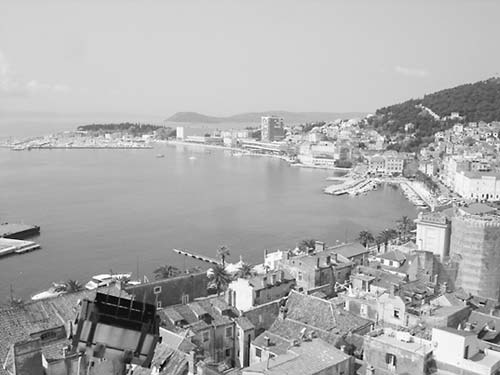
Split’s domino-shaped Old Town is made up of two square sections. The east half was once Diocletian’s Palace, and the west half is the medieval town that sprang up next door. The shell of Diocletian’s ruined palace provides a checkerboard street plan, with a gate at each end. But the streets built since are anything but straight, making the Old Town a delightfully convoluted maze (double-decker in some places). At the center of the former palace is a square called the Peristyle (Peristil), where you’ll find the TI, cathedral, and highest concentration of Roman ruins.
Split has two TI locations: One is in the little chapel on the square called the Peristyle, in the very center of Diocletian’s Palace, and the other is on the Riva at #9, facing the harbor (same hours for both: May-Sept Mon-Sat 8:00-21:00, Sun 8:00-13:00—longer if there’s a cruise ship in town; April and Oct Mon-Sat 8:00-20:00, Sun 8:00-13:00; Nov-March Mon-Fri 9:00-16:00, Sat 9:00-13:00, closed Sun; Peristyle tel. 021/345-606, Riva tel. 021/360-066, www.visitsplit.com). The TIs hand out a stack of free info: a good town map, the Discover Split newspaper (with an even more detailed map), Split in Your Pocket mini-guidebooks and maps, and piles of brochures.
Sightseeing Pass: If you’re staying in town at least three nights, bring your hotel reservation to the TI to claim your Splitcard, which covers free admission to several sights (including the City Museum, Ethnographic Museum, and cathedral) and offers a 50 percent discount at other sights (including the Meštrović Gallery, Archaeological Museum, and Gallery of Fine Arts), plus minor discounts at other attractions, shops, and restaurants around town. Busy sightseers staying less than three nights may find the card worth paying for; you can buy one a few doors down from the Riva TI at Turistički Biro, at #12 on the Riva (35 kn/72 hours).
By Boat, Bus, or Train: Split’s ferry terminal (Trajektni Terminal), main bus station (Autobusni Kolodvor), and train station (Željeznička Stanica) all share a busy and practical strip of land called Obala Kneza Domagoja, on the east side of the City Harbor. From any of them, you can see the Old Town and Riva; just walk around the harbor toward the big bell tower (about a 10-minute walk). Along the way, you’ll pass travel agencies, baggage-storage offices, people trying to rent rooms, a post office, Internet cafés, shops, and cafés. Arriving or leaving from this central location, you never need to deal with the concrete, exhaust-stained sprawl of outer Split.
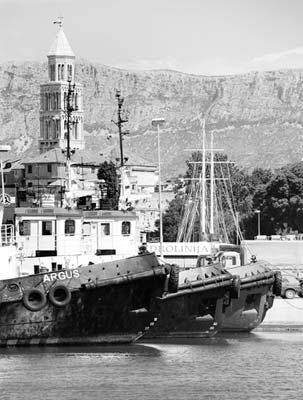
Boats arrive at various piers. The Jadrolinija passenger catamaran to and from Hvar and Korčula usually docks at the Obala Lazareta embankment, right in front of the Old Town. The Krilo passenger catamaran to those destinations—and, sometimes, the Jadrolinija catamaran as well—uses pier #11, partway along the harbor. Bigger car ferries use various docks along the harbor. The main terminal, at the far end, has ATMs, WCs, a grocery store, and the large Jadrolinija ticket and information office, which is open long hours daily and generally has a helpful English-speaking staff.
By Cruise Ship: In recent years—as packed-to-the-gills Dubrovnik has had to turn away cruise ships—Split has become a popular port of call for Mediterranean cruises. Dubrovnik’s loss is Split’s gain—and passengers’ gain too, as the city is particularly easy to see in a quick visit. Cruise ships either dock along the main harbor in front of the Old Town, or anchor in the harbor and send tenders into the harbor (for directions on the short walk to the Old Town, see above).
By Plane: Split’s airport (Zračna Luka Split-Kaštela) is across the big bay, 15 miles northwest of the center, near the town of Trogir (tel. 021/203-506, www.split-airport.hr). Buses operated by three different companies (Croatia Airlines, Promet, and Žele) connect the airport to the main bus station along Split’s harbor (see arrival instructions earlier). While each bus has its own schedule, at least one departs every 30 minutes or so, and they cost about the same (30-35 kn); just take whichever bus is leaving next (at Split’s bus station, all companies use stall #5). Another option is to take public bus #37, which stops along the main road in front of the airport (21 kn, 3/hour Mon-Fri, 2/hour Sat-Sun, 45 minutes; this bus also connects Split and Trogir); the catch is that bus #37 uses Split’s suburban bus station, which is a dreary 10-minute walk north of downtown. The most expensive option is a taxi, which costs a hefty 250 kn between the airport and downtown Split.
By Car: For details on arriving in Split by car, driving between northern Croatia and Split, and driving south to the rest of the Dalmatian Coast, see “Route Tips for Drivers,” on here.
Festivals: For one week in late August, Split celebrates Diocletian Days, when 50 actors from Rome walk the streets in ancient garb. A boat brings “Diocletian” to the Riva, people wearing togas attend dinner in the palace cellars, and the Diocletian Games are staged along the Riva.
Internet Access: Internet cafés are plentiful in the Old Town; look for signs, especially around the Peristyle, or try Modrulj Launderette (described later). Closer to the stations and ferry terminal, Backpacker C@fé has Internet access, coffee and drinks with outdoor seating, luggage storage, and used paperbacks for sale (30 kn/hour, Wi-Fi-15 kn/hour, daily July-Aug 6:30-21:00, shoulder season 7:00-20:30, shorter hours off-season, near the beginning of Obala Kneza Domagoja, tel. 021/338-548). For locations, see map above.
Post Office: A modern little post office is next to the bus station. They sell empty boxes, so this is a good opportunity to mail home any dead weight you’ve accumulated (Mon-Fri 7:00-20:00, Sat 7:00-13:00, closed Sun, on Obala Kneza Domagoja).
Luggage Storage: Seemingly custom-made for a quick stopover between Dalmatian destinations, this transit hub has no shortage of luggage-storage options. The train station has lockers, and the adjacent bus station has a left-luggage desk (garderoba). A small luggage-storage kiosk is along the sidewalk between the stations and the Old Town. All of these options cost 15 kn for the day; anyone charging more is ripping you off. Just west of the Old Town, Modrulj Launderette (described next) also has a left-luggage service.
Laundry: Modrulj Launderette, a rare self-service launderette, is conveniently located in the Varoš neighborhood at the west end of the Old Town, near several recommended restaurants—handy if multitasking is your style (self-service-50 kn/load, full-service-75 kn/load, air-con, Internet access, left-luggage service; April-Oct daily 8:00-20:00; Nov-March Mon-Sat 9:00-17:00, closed Sun; Šperun 1—see map on here, tel. 021/315-888).
Bike Rental: Several places around town rent bikes; one central location is Travel49 (60 kn/4 hours, 100 kn/day, Dioklecijanova 5, mobile 098-858-141). They also plan to offer three-hour bike tours for “one penny” (but you pay for the bike rental, and the guide expects a tip). Another option is Baracuda (listed next). One good—if strenuous—option is a loop around the nearby Marjan peninsula, with a stop at a beach.
Boat Rental: As the transportation hub of the Dalmatian Coast, Split is a handy place to rent your own boat. Baracuda, which faces the Matejuška fishermen’s port, rents a wide range of boats (one day costs €160-1,600, depending on the boat; you can pay €80 extra to hire a skipper). They also offer transfers to the islands (e.g., €370 to Hvar, €710 to Korčula), scuba diving (€50/1.5 hours for beginners, €95/5 hours for licensed divers), fishing trips (€100/person for 1-2 people, €65/person for 3 or more, about 5 hours), and bike rental (20 kn/hour, 60 kn/4 hours; daily 8:00-20:00, closed Sun in winter, Trumbićeva Obala 13, tel. 021/362-462, mobile 091-566-5741, www.baracuda.hr, baracuda@st.t-com.hr).
Who’s Hajduk?: You’ll see the word Hajduk (HIGH-dook), and a distinctive red-and-white checkerboard circle design (or red-and-blue stripes), all over town and throughout northern Dalmatia. Hajduk Split is the fervently supported soccer team, named for a band of highwaymen bandits who rebelled against Ottoman rule in the 17th-19th centuries. Most locals adore Hajduk as much as they loathe their bitter rivals, Dinamo Zagreb.
G’day, Gospod: You may notice a surprising concentration of Australians in Split. Many of them are actually Australian-born Croats, returning to the cosmopolitan capital city of their parents’ Dalmatian homeland.
Most of what you’ll want to see is within walking distance, but some sights (such as the Meštrović Gallery) are more easily reached by bus or taxi.
By Bus: Local buses, run by Promet, cost 11 kn per ride (or 10 kn if you buy a ticket at a newsstand or Promet kiosk, ask for a putna karta; zone I is fine for any ride within Split, but you need the 21-kn zone IV ticket for the ride to Trogir). For a round-trip within the city, buy a 17-kn transfer ticket, which works like two individual tickets (must buy at kiosk). Validate your ticket in the machine or with the driver as you board the bus. Suburban buses to towns near Split (such as Trogir) generally use the suburban bus station (Prigradski Autobusni Kolodvor), a 10-minute walk due north of the Old Town on Domovinskog rata. Bus information: www.promet-split.hr.
By Taxi: Taxis start at 20 kn, then cost around 8 kn per kilometer. Figure 50 kn for most rides within the city (for example, from the ferry terminal to most hotels)—but if going from one end of the Old Town to the other, it can be faster to walk. To call for a taxi, try Radio Taxi (tel. 021/1777).
By Tourist Train: An hourly tourist train leaves from the square at the top of Marmontova and does a loop around the Marjan peninsula with a stop at Bene Beach (20 kn one-way, departs on the hour 9:00-20:00, mobile 095-530-6962).
Split’s Old Town, with fragments of Diocletian’s Palace, is made to order for a walking tour, and it seems that Split has hundreds of tour guides leading cruise-ship excursions around the town. My self-guided walk (described later) covers basically the same information you’ll get from a guide. But if you’d like to hear it live, join a tour. This is a constantly changing scene, but on my last visit, two fiercely competitive companies were offering dueling 1.25-hour walks, leaving about every 60 to 90 minutes throughout the day and into the evening. The red Sirena tours cost 100 kn and have a more purely historical focus; the blue “Walking Tour for a Penny” costs one kuna (plus the guide expects a 30-50-kn tip per person) and is more overtly commercial, cross-promoting the company’s other offerings. I’d pay a bit extra for a more serious operation, but you can chat with the umbrella-toting touts to find out what your options are. Yet another choice: The local guides association offers tours three times daily in summer (100 kn, May-Sept Mon-Sat at 10:00, 11:30, and 13:00); while these guides are usually more polished and professional, the starting point—at their office on the Riva (see map on here)—is a little less convenient.
You can hire an insider to show you around. Maja Benzon is a smart and savvy local guide; she leads good walking tours through the Old Town (500 kn/up to 2 hours, 600 kn/3 hours, mobile 098-852-869, maja.benzon@gmail.com). You can also hire a guide through the guides association, which has an office on the Riva (525 kn/1.5-2 hours; May-Sept Mon-Fri 8:30-17:30, Sat 9:00-15:00, closed Sun; off-season generally open weekday mornings only; Obala Lazareta 3, tel. 021/360-058 or 021/346-267, mobile 098-361-936, www.guides.hr, info@guides.hr).
A staggering variety of pop-up travel agencies sell tickets for bus or boat excursions to nearby destinations. There’s no shortage of enticing side-trips: the town of Trogir; the Roman ruins of Solin (ancient Salona); whitewater rafting on the Cetina River; the islands of Brač, Hvar, and Šolta (either separately or together; the “Blue Cave” on Vis is another favorite); the pilgrimage site at Međugorje; Dubrovnik; and the waterfalls at Krka National Park or Plitvice Lakes National Park. Because new companies come and go every year, I can’t recommend any outfit in particular. If you’re interested in a side-trip, comparison-shop for a tour that suits your interests.
Various tour boats line up along the Riva each morning and evening, hawking trips to nearby islands. Popular itineraries include a combination cruise to Hvar and the “Green Cave” and “Blue Cave” on Vis, all in one day. Aside from the standard side-trips, there are a few more interesting or adventurous alternatives. For example, the Summer Blues catamaran does party-oriented “sail ’n swim” cruises with swimming stops, dancing, food, and lots of drinks (www.summer-blues.com). Various companies also offer kayaking tours from Split.
(See “Diocletian’s Palace” map, here.)
Split’s top activity is visiting the remains of Roman Emperor Diocletian’s enormous retirement palace, which sits on the harbor in the heart of the city. This monstrous complex was two impressive structures in one: luxurious villa and fortified Roman town. My walk takes you through Diocletian’s back door; down into the labyrinth of cellars that supported the palace; up to the Peristyle (the center of the palace); into Diocletian’s mausoleum—now the town’s cathedral, with a crypt, treasury/museum, and climbable tower; over to Jupiter’s Temple (later converted into a baptistery); down the main artery of the palace; and finally to what was once the palace’s front entrance. The ruins themselves are now integrated with the city’s street plan, so exploring them is free—except for the cellars and the cathedral sights/temple, which you’ll pay to enter. In peak season, the cellars are open late (on most days until 20:00 or 21:00), and the cathedral sights generally close at 19:00. If visiting off-season, do this walk as early as possible, because the cathedral sights close at noon. For exact hours, see the individual sight listings.
Fragments of the palace are poorly marked, and there are no good guidebooks or audioguides for understanding the remains. For most visitors, this walk provides enough details; for more in-depth information, you could join a walking tour or hire a guide (see “Tours in Split,” earlier).
Diocletian grew up just inland from Split, in the town of Salona (Solin in Croatian), which was then the capital of the Roman province of Dalmatia. He worked his way up the Roman hierarchy and ruled as emperor for the unusually long tenure of 20 years (A.D. 284-305). Despite all of his achievements, Diocletian is best remembered for two questionable legacies: dividing the huge empire among four emperors (which helped administer it more efficiently, but began a splintering effect that arguably led to the empire’s decline); and torturing and executing Christians, including thousands right here on the Dalmatian Coast. Soon after the end of Diocletian’s reign, his successor, Constantine, not only legalized Christianity, but made it the official religion of the empire—effectively making Diocletian’s purges some of the last in Roman history.
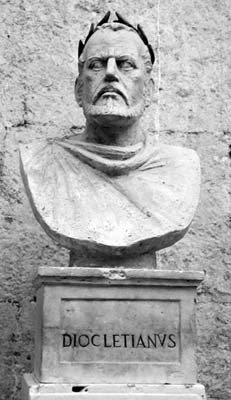
As Diocletian grew older, he decided to return to his homeland for retirement. Since he was in poor health, the medicinal sulfur spring here was another plus. His massive palace took only 11 years to build—and this fast pace required a big push (more than 2,000 slaves died during construction). Huge sections of his palace still exist, modified by medieval and modern developers alike.
• Start in front of the palace, at the east end of the Riva. To get a sense of the original palace, check out the big illustration posted across from the palace entry. Across the street at the end of the Riva, notice the big car-size model of today’s Old Town, which is helpful for orientation. (Both the sign and the model are usually crowded with tour groups.) Now study the...
The “front” of today’s Split—facing the harbor—was actually the back door of Diocletian’s Palace. There was no embankment in front of the palace back then, so the water came right up to this door—sort of an emergency exit by boat. Looking out to the water, appreciate the palace’s strategic location: It’s easy to fortify, and to spot enemies approaching either by land or by sea.
Visually trace the outline of the gigantic palace, which was more than 600 feet long on each side. On the corner to the right stands a big, rectangular guard tower (one of the original 16). To the left, the tower is gone and the corner is harder to pick out (look for the beginning of the newer-looking buildings). Mentally erase the ramshackle two-story buildings added 200 years ago, which obscure the grandeur of the palace wall.
Halfway up the facade, notice the row of 42 arched window frames (mostly filled in today). Diocletian and his family lived in the seaside half of the palace. Imagine him strolling back and forth along this fine arcade, enjoying the views of his Adriatic homeland. The inland, non-view half of the palace was home to 700 servants, bodyguards, and soldiers.
• Go through the door in the middle of the palace (known as the “Brass Gate,” located under The Substructure of Diocletian’s Palace banner). Just inside the door and to the left is the entrance to...
Since the palace was constructed on land that sloped down to the sea, these chambers were built to level out a foundation for the massive structure above (like a modern “daylight basement”). These cellars were filled with water from three different sources: a freshwater spring, a sulfur spring, and the sea. Later, medieval residents used them as a dump. Rediscovered only in the last century, the cellars enabled archaeologists to derive the floor plan of some of the palace’s long-gone upper sections. These underground chambers now house art exhibits and a little strip of souvenir stands. One particularly well-preserved stretch can be toured, offering the best look in town at Roman engineering.
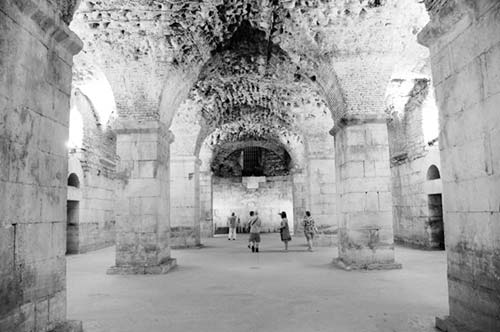
Cost and Hours: 40 kn, some posters inside explain the site; June-Sept daily 9:00-21:00; April-May and Oct Mon-Sat 9:00-20:00, Sun 9:00-18:00 except in April, when it closes Sun at 14:00; Nov-March Mon-Sat 9:00-18:00, Sun 9:00-14:00.
Visiting the Cellars: Use the free map you get at the entry to navigate this labyrinthine complex of cellars. First visit the western cellars (to the left as you enter). Near the ticket-seller, notice the big topographical map of the Split area, clearly showing the city’s easily defensible location—with a natural harbor sheltered by tall mountains. You’ll see the former Roman city of Salona, Diocletian’s birthplace, just inland.
This network of cellars is quite a maze, so follow these instructions carefully: Head into the main part of the cellars by going through the door on the right, just past the ticket-seller. This takes you into the complex’s vast, vaulted main hall—the biggest space in the cellars, with stout pillars to support everything upstairs. When those first villagers took refuge in the abandoned palace from the rampaging Slavs in 641, the elite lived upstairs, grabbing what was once the emperor’s wing. They carved the rough holes you see in the ceiling to dump their garbage and sewage. Over the generations, the basement (where you’re standing) filled up with layers of pungent waste that solidified, ultimately becoming a precious bonanza for 19th- and 20th-century archaeologists. Today this hall is used for everything from flower and book shows to fashion catwalks. (And, in 2013, it was used to film scenes for HBO’s Game of Thrones.)
Exit the main hall through either of the doors on the left, cross through the narrow corridor, and enter the long room. Look just overhead—the holes you see once held beams to support floorboards, making this a two-story cellar. Face the giant replica of a golden Diocletian coin at the far end, and turn left, then immediately right into a small circular room, which has a headless, pawless black granite sphinx—one of 13 that Diocletian brought home from Egypt (only four survive, including a mostly intact one we’ll see soon on the Peristyle). Look up to admire the circular brickwork. Then continue straight into another small room, which adjoins one that displays a stone olive-oil press.
Backtrack through the round room and into a room that displays two petrified beams, like the ones that once filled the double-decker holes we saw earlier. At the far (right) end of this room is an unexcavated wing—a compost pile of ancient lifestyles, awaiting the tiny shovels and toothbrushes of future archaeologists.
Facing the mound of ancient garbage, turn left into another round room, featuring a bust of Diocletian (or is it Sean Connery?). From here, turn left and go through another room (passing WCs on the right) to return to the long room you were in earlier, then turn right and exit out the bottom of this hall. On your right, look for original Roman sewer pipes—square outside and round inside—designed to fit into each other to create long pipes.
From here, head back out to the exit. If you’d like to see more cellars—mostly with their ceilings missing, so they’re open to the air—cross over into the eastern cellars (same ticket). This section is less interesting than the western part, but worth a quick visit.
• When you’re finished, head back to the main gallery. Ignore the tacky made-in-Malaysia trinket shops as you head down the passage and up the chunky stairs into the...
This square was the centerpiece of Diocletian’s Palace. As you walk up the stairs, the entry vestibule into the residence is above your head, Diocletian’s mausoleum (today’s Cathedral of St. Dominus) is to your right, and the street to Jupiter’s Temple (supported by wooden beams) is on your left. The TI is in the small chapel, at the end of the square on the right. Straight ahead, beyond the TI/chapel, is the narrow street that leads to the palace’s former main entrance, the Golden Gate.
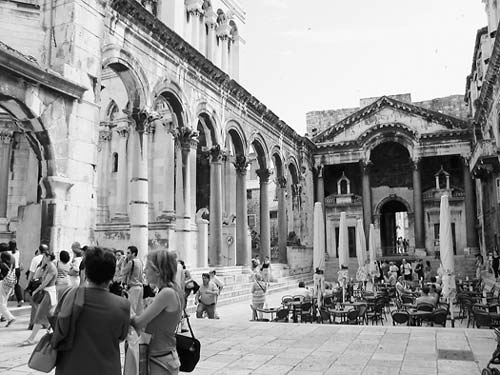
Go to the middle of the square and take it all in. The red granite pillars—which you’ll see all over Diocletian’s Palace—are from Egypt, where Diocletian spent many of his pre-retirement years. Imagine the pillars defining fine arcades—now obscured by medieval houses. The black sphinx is the only one of Diocletian’s collection of 13 that’s still (mostly) intact.
“Roman soldiers” pose for tips (daily 9:00-17:00), and every day at noon in summer (mid-June-mid-Sept), an actor playing Diocletian appears at the top of the stairs to address the crowd in Latin.
Without realizing it, you’re standing in the middle of one of Split’s most inviting bars, Luxor. The red cushions on the steps ringing the square belong to the bar; if you want to sit on one, you have to buy a drink (especially worthwhile in the evening, when the Peristyle is less crowded and there’s often live music).
• Climb the stairs (above where you came in) into the domed, open-ceilinged...
Impressed? That’s the idea. This was the grand entry to Diocletian’s living quarters, meant to wow visitors. Emperors were believed to be gods. Diocletian called himself “Jovius”—the son of Jupiter, the most powerful of all gods. Four times a year (at the changing of the seasons), Diocletian would stand here and overlook the Peristyle. His subjects would lie on the ground in worship, praising his name and kissing his scarlet robe. Notice the four big niches at floor level, which once held statues of the four tetrarchs who ruled the unwieldy empire after Diocletian retired. The empty hole in the ceiling was once capped by a dome (long since collapsed), and the ceiling itself was covered with frescoes and mosaics.
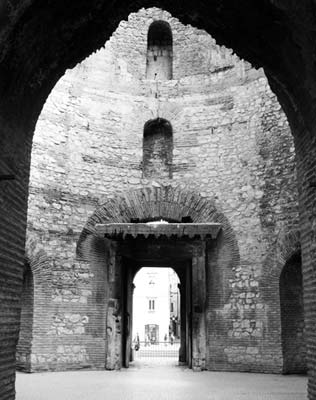
In this grand space, you’ll likely run into an all-male band of klapa singers, performing traditional a cappella harmonies. Just stand and enjoy a few glorious tunes—you’ll rarely find a better group or acoustics. A 100-kn klapa CD is the perfect souvenir.
Wander out back to the harborside through medieval buildings (some with seventh-century foundations), which evoke the way local villagers came in and took over the once-spacious and elegant palace. Back in this area, you’ll find the beautifully restored home of the Ethnographic Museum (described later, under “Sights in Split”).
• Now go back into the Peristyle and turn right, climbing the steps to the...
The original octagonal structure was Diocletian’s elaborate mausoleum, built in the fourth century. But after the fall of Rome, it was converted into the town’s cathedral. Construction of the bell tower began in the 13th century and took 300 years to complete. Before you go inside, notice the sarcophagi ringing the cathedral. In the late Middle Ages, this was prime post-mortem real estate, since being buried closer to a cathedral improved your chances of getting to heaven.
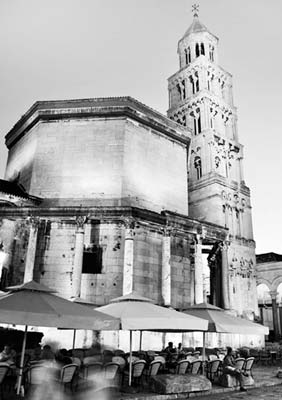
Cost and Hours: Several sights associated with the cathedral require tickets: the cathedral interior, the unimpressive treasury/museum, the crypt, the tower climb, and—a block away—Jupiter’s Temple (described later). While ticketing options always seem in flux, you’ll likely have an option to pay 25 kn for the cathedral, crypt, and baptistery (the three most worthwhile parts); a 45-kn ticket adds the skippable treasury/museum and steep-but-scenic bell tower. (You can also pay 15 kn just for the tower climb—buy ticket at tower door.) All of the sights are open similar hours, but the cathedral can close unexpectedly for services. In general, hours are summer Mon-Sat 8:00-19:00, Sun 12:30-18:30, cathedral often closed Sat afternoons for weddings; winter daily 7:00-12:00, maybe later on request; Kraj Sv. Duje 5, tel. 021/345-602.
Visiting the Cathedral: To get inside in peak season (April-Oct), you must loop around the outside of the cathedral. Facing the main door at the bottom of the stairs, circle around the right side—passing the crypt (included in the cathedral ticket and described later)—to find the door in the building behind. Buy your ticket here and climb up the stairs. (In winter, you can usually enter the cathedral through the main door.) Once inside, the first flight of stairs leads to the cathedral interior (described next), but if you bought the 45-kn ticket and want to see the treasury/museum first, head up one more flight. The single-room museum contains dusty display cases of vestments, giant psalter books, icon-like paintings, reliquaries, chalices, monstrances, and other church art, with very sparse English descriptions. After visiting, head back down to the cathedral.
Step into the church interior. You’ll enter into the apse; head around the side of the altar to reach the main (though still tiny) part of the church. This is the oldest—and likely smallest—building used as a cathedral anywhere in Christendom. Imagine the place in pre-Christian times, with Diocletian’s tomb in the center. The only surviving pieces of decor from those days are the granite columns and the relief circling the base of the dome (about 50 feet up)—a ring of carvings heralding the greatness of the emperor. The small red-marble pillars around the top of the pulpit (near the main door) were scavenged from Diocletian’s sarcophagus. These pillars are all that remain of Diocletian’s remains.
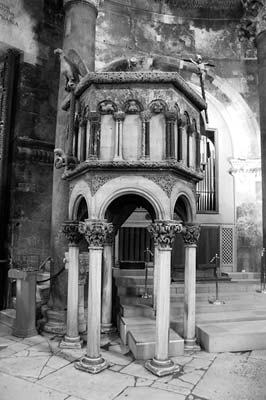
Diocletian brutally persecuted his Christian subjects. Just before he moved to the Dalmatian Coast, he had Bishop Dominus of Salona killed, along with several thousand Christians. When Diocletian died, there were riots of happiness. In the seventh century, his mausoleum became a cathedral dedicated to the martyred bishop. The apse (behind the altar) was added in the ninth century. The sarcophagus of St. Dominus (to the right of the altar, with early-Christian carvings) was once the cathedral’s high altar. To the left of today’s main altar is the impressively detailed, Renaissance-era altar of St. Anastasius, who is lying on a millstone that is tied to his neck. On Diocletian’s orders, this Christian martyr was drowned in A.D. 302. To the left of St. Anastasius’ altar is the “new” altar of St. Dominus; his relics lie in the 18th-century Baroque silver reliquary, above a stone relief showing him about to be beheaded. Posthumous poetic justice: Now Christian saints are entombed in Diocletian’s mausoleum...and Diocletian is nowhere to be found. As you exit through the 13th-century main doors, notice the 14 panels on each of the two wings—showing 28 scenes from the life of Christ.
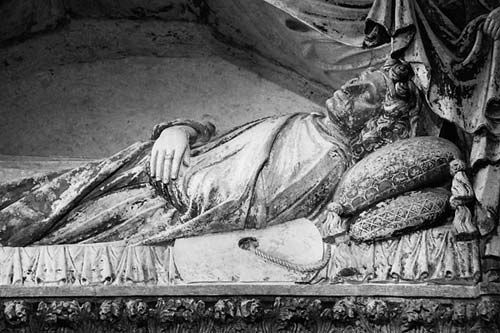
Exiting the church, you’ll see the entrance to the bell tower on your right. Climbing the 183 steep steps to the top of the 200-foot-tall bell tower rewards you with sweeping views of Split, but it’s not for claustrophobes or those scared of heights.
To visit the crypt (kripta), also included with your ticket, exit the main door of the cathedral, go down the stairs, and loop left to find its low-profile entrance. This musty, domed cellar (with eerie acoustics) was originally used to level the foundation of Diocletian’s mausoleum. Later, Christians turned it into another chapel, dedicated to the Italian Saint Lucia, who was martyred by Diocletian. (The legend you’ll likely hear about Diocletian torturing and murdering Christians in this very crypt, which began about the same time this became a church, is probably false.) Lucia stands above a small altar where the faithful have left scraps of paper scrawled with their prayers and their thanks. Ponder the contrast of this dark and gloomy space with Santa Lucia, whose name means “light.” Notice the freshwater well in the middle of the room. Because this water was believed to have healing properties, the faithful would wash their eyes with it (particularly appropriate, since Santa Lucia is also the patron saint of eyesight).
• Return to the middle of the Peristyle square. Remember that Diocletian believed himself to be Jovius (Jupiter, Jr.). As worshippers exited the mausoleum of Jovius, they would look straight ahead to the temple of Jupiter. (Back then, there were none of these medieval buildings cluttering up the view.) Make your way through the narrow alley (directly across from the cathedral entry), past another headless, pawless sphinx, to explore the small...
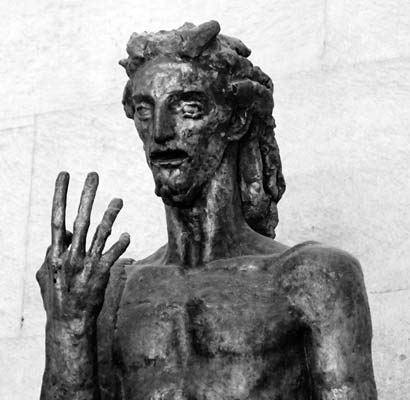
About the time the mausoleum became a cathedral, this temple was converted into a baptistery (same ticket and hours as cathedral; off-season, if it’s locked, go ask the person at the cathedral to let you in). Inside, the big 12th-century baptismal font—large enough to immerse someone (as was the tradition in those days)—is decorated with the intricate, traditional woven-rope pleter design. Observant travelers will see examples of this motif all over the country. On the font, notice the engraving: a bishop (on the left) and the king on his throne (on the right). At their feet (literally under the feet of the bishop) is a submissive commoner—neatly summing up the social structure of the Middle Ages. Standing above the font is a statue of St. John the Baptist counting to four, done by the great Croatian sculptor Ivan Meštrović (see here). The half-barrel vaulted ceiling, completed later, is considered the best-preserved of its kind anywhere. Every face and each patterned box is different.
• Back at the Peristyle, stand in front of the little chapel with your back to the square. The small street just beyond the chapel (going left to right) connects the east and west gates. If you’ve had enough Roman history, head right (east) to go through the Silver Gate and find Split’s busy, open-air Green Market. Or, head to the left (west), which takes you to the Iron Gate and People’s Square (see “Sights in Split,” later) and, beyond that, the fresh-and-smelly fish market. But if you want to see one last bit of Roman history, continue straight ahead up the...
A traditional Roman street plan has two roads: Cardo (the north-south axis) and Decumanus (the east-west axis). Split’s Cardo street was the most important in Diocletian’s Palace, connecting the main entry with the heart of the complex. As you walk, you’ll pass several noteworthy sights: in the first building on the right, a bank with modern computer gear all around its exposed Roman ruins (look through window); at the first gate on the left, the courtyard of a Venetian merchant’s palace (a reminder that Split was dominated by Venice from the 15th century on); farther along on the right, an alley to the City Museum (described later, under “Sights in Split”); and, beyond that on the right, Nadalina, an artisan chocolatier selling mostly dark chocolate creations with some innovative Dalmatian flavors—such as dried fig and prosecco (32 kn/100 grams, chocolate bars, Mon-Fri 8:30-20:30, Sat 9:00-14:00, closed Sun, mobile 091-210-8889).
At the end of the street, just before the Golden Gate, detour a few steps to the left along covered Majstora Jurja street—lined with some of the most appealing outdoor cafés in town, lively both day and night (described later, under “Nightlife in Split”). Near the start of this street, just after its initial jog, stairs climb to the miniscule St. Martin’s Chapel, burrowed into the city wall. Dating from the fifth century, this is one of the earliest Christian chapels anywhere. St. Martin is the patron saint of soldiers, and the chapel was built for the troops who guarded this gate (free, sporadic hours—just climb the stairs to see if it’s open).
• Backtrack to the main drag and go inside the huge...
This great gate was the main entry of Diocletian’s Palace. Its name wasn’t literal—rather, the “gold” suggests the importance of this gateway to Salona, the Roman provincial capital at the time. Standing inside the gate itself, you can appreciate the double-door design that kept the palace safe. Also notice how this ancient building is now being used in very different ways from its original purpose. Above, on the outer wall, you can see the bricked-in windows that contain part of a Dominican convent. At the top of the inner wall is somebody’s garden terrace.
Go outside the gate and look back at the recently restored fortification—with all its structural elements gleaming. This mostly uncluttered facade gives you the best opportunity in town to visualize how the palace looked before so many other buildings were grafted on. Straight ahead as you exit this gate is Salona (Solin), which was a major city of 60,000 (and Diocletian’s hometown) before there was a Split. The big statue by Ivan Meštrović is Bishop Gregory of Nin, a 10th-century Croatian priest who tried to convince the Vatican to allow sermons during Mass to be said in Croatian, rather than Latin. People rub his toe for good luck (though only nonmaterial wishes are given serious consideration). The big building beyond the statue houses Split’s Gallery of Fine Arts (described later, under “Sights in Split”).
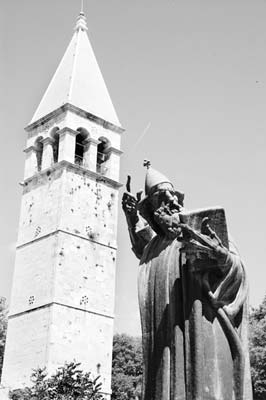
• Your tour is finished. Now enjoy the rest of Split.
▲People’s Square (Narodni Trg)
Radić Brothers Square (Trg Braće Radića)
Ethnographic Museum (Etnografski Muzej)
Split City Museum (Muzej Grada Splita)
Split Gallery of Fine Arts (Galerija Umjetnina Split)
Archaeological Museum (Arheološki Muzej)
Ivan Meštrović Sights, West of the Old Town
▲▲Meštrović Gallery (Galerija Meštrović)
In addition to the palace, cellars, and cathedral described on my self-guided walk, you can also enjoy these attractions.
My self-guided walk (described earlier) takes you through the main artery of town, but just a few steps away are some delightful squares and other public zones that are worth exploring.
The official name for this seaside pedestrian drag is the “Croatian National Revival Embankment” (Obala Hrvatskog Narodnog Preporoda), but locals just call it “Riva” (Italian for “harbor”). This is the town’s promenade, an integral part of Mediterranean culture. After dinner, Split residents collect their families and friends for a stroll on the Riva. It offers some of the best people-watching in Croatia; make it a point to be here for an hour or two after dinner. The stinky smell that sometimes accompanies the stroll (especially at the west end) isn’t from a sewer. It’s sulfur—a reminder that the town’s medicinal sulfur spas have attracted people here since the days of Diocletian.
The Riva is a broad, sleek, carefully landscaped people zone. A clean, synchronized line of modern white lampposts and sun screens sashays down the promenade. Some think that the starkly modern strip is at odds with the rest of the higgledy-piggledy Old Town, while others see this as simply the early-21st century’s contribution to the architectural hodgepodge that is Split.
At the west end of the Riva, the people-parade of Croatian culture turns right and heads away from the water, up Marmontova. Although it lacks the seafront cachet, this drag is equally enjoyable and feels more local. As you walk up Marmontova, on the left is the plain-Jane outer facade of the arcade that defines Trg Republike, a grand and genteel Napoleonic-era square. Duck through the passage across from the fish market to bask in its “poor man’s St. Mark’s Square” ambience, and maybe to linger over a drink at the recommended Bajamonti café. A bit farther up Marmontova, on the right, look for the whimsical fountain nicknamed “The Teacup,” with a hand squirting water across the sidewalk into a funnel. At the top of Marmontova are some department stores, a lively café square, and the Croatian National Theater (Hrvatsko Narodno Kazalište, HNK).
Locals call this lively square at the center of the Old Town Pjaca, pronounced the same as the Italian piazza (PYAH-tsah). Stand in the center and enjoy the bustle. Look around for a quick lesson in Dalmatian history. When Diocletian lived in his palace, a Roman village popped up here, just outside the wall. Face the former wall of Diocletian’s Palace (behind and to the right of the 24-hour clock tower). This was the western entrance, or so-called “Iron Gate.” By the 14th century, a medieval town had developed, making this the main square of Split.
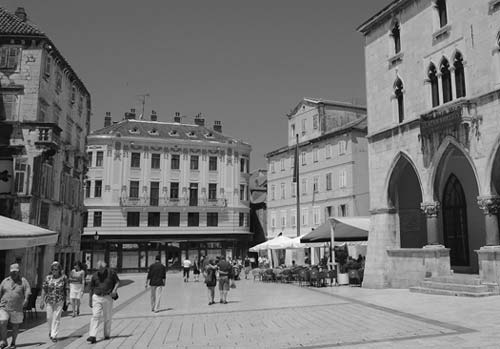
On the wall just to the right of the lane leading to the Peristyle, look for the life-size relief of St. Anthony. Notice the creepy “mini-me” clutching the saint’s left leg—depicting the sculptor’s donor, who didn’t want his gift to be forgotten. Above this strange statue, notice the smaller, faded relief of a man and a woman arguing.
Turn around and face the square. On your left is the city’s grand old café, Gradska Kavana, which has been the Old Town’s venerable meeting point for generations. Today it’s both a café and a restaurant, with disappointing food but the best outdoor ambience in town.
Across the square, the white building jutting into the square was once the City Hall, and now houses temporary exhibitions. The loggia is all that remains of the original Gothic building.
At the far end of the square is the out-of-place Nakić House, built in the early 20th-century Viennese Secession style—a reminder that Dalmatia was part of the Habsburg Empire, and ruled by Vienna, from Napoleon’s downfall through World War I.
The lane on the right side of the Nakić House leads to Split’s fish market (Ribarnica), where you can see piles of the still-wriggling catch of the day. No flies? It’s thanks to the sulfur spring in the nearby spa building (with the gray statues, on the corner). Just beyond the fish market is the pedestrian boulevard, Marmontova (described earlier).
This little piazza is just off the Riva between the two halves of the Old Town. Overhead is a Venetian citadel. After Split became part of the Venetian Republic, there was a serious danger of attack by the Ottomans, so octagonal towers like this were built all along the coast. But this imposing tower had a second purpose: to encourage citizens of Split to forget about any plans of rebellion. At its base is an inviting juice bar, invoking the more popular nickname of the square—Voćni Trg (“Fruit Square”), for the produce that was once sold here.
In the middle of the square is a studious sculpture by Ivan Meštrović of the 16th-century poet Marko Marulić, who is considered the father of the Croatian language. Marulić was the first to write literature in the Croatian vernacular, which before then had generally been considered a backward peasants’ tongue.
On the downhill (harbor) side of the square is Croata, a necktie boutique that loves to explain how Croatian soldiers who fought with the French in the Thirty Years’ War (1618-1648) had a distinctive way of tying their scarves. The French found it stylish, adopted it, and called it à la Croate—or eventually, cravate—thus creating the modern necktie that many people wear to work every day throughout the world. Croata’s selection includes ties with traditional Croatian motifs, such as the checkerboard pattern from the flag or writing in the ninth-century Glagolitic alphabet. Though pricey, these ties make nice souvenirs. Basic ties run about 500 kn, while handmade ones with 24-carat gold accents can run 2,800-3,800 kn. The shop also sells women’s scarves (Mon-Fri 8:00-20:00, Sat 8:00-13:00, closed Sun, Mihovilova Širina 7, tel. 021/346-336). Croata has a bigger, second location on the Peristyle.
This lively open-air market bustles at the east end of Diocletian’s Palace. Residents shop for produce and clothes here, and there are plenty of tourist souvenirs as well. Browse the wide selection of T-shirts, and ignore the sleazy black-market tobacco salesmen who mutter at you: “Cigaretta?”
While Split’s harborfront Riva is where the beautiful people stroll, the city’s fishermen roots still thrive just to the west. The neighborhood called Matejuška—at the little harbor where the Varoš district hits the water (a five-minute walk beyond the end of the Riva, with the water on your left)—has long been Split’s working fishermen’s harbor. While the area has received a facelift to match the one along the Riva, it still retains its striped-collar character. The enclosed harbor area is filled with working fishing boats and colorful dinghies that bob in unison. Along the breakwater, notice the new fishermen’s lockers, where people who earn their living from the Adriatic still keep their supplies. You’ll see the most fishing action here in the mornings.
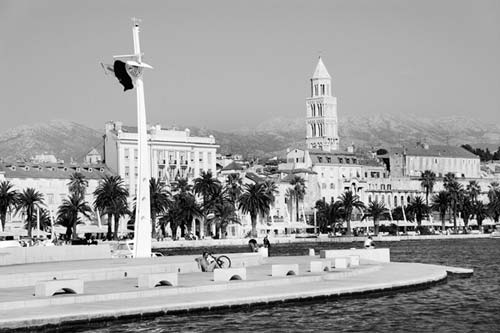
The far side of the breakwater—all glitzy white marble—is another world, with a pebbly beach, attractive plaza, and some of the best views looking back on the Riva. After its recent renovation, this jetty has become a popular open-air, after-hours hangout for young people. Like Split itself, these two worlds—the grizzled fishermen mending their nets, and the teenagers laughing and flirting—coexist more smoothly than anyone might have guessed.
Beyond Matejuška, the harborfront embankment (which runs toward the Marjan peninsula) has also been rejuvenated and is now spiffed up with cafés facing moored sailboats, creating a relaxing, scenic, largely tourist-free zone.
This museum shows off the culture, costumes, furniture, tools, jewelry, weapons, and paintings of Dalmatia. The modest but vibrant collection, with a confusing treehouse floor plan, is displayed in a gorgeously renovated early-medieval palace (parts of which once formed the private residential halls of Diocletian). You’ll find it in the upper level of the Old Town, behind Diocletian’s entry vestibule. Check out the artsy “golden fleece” entry door. The ground floor sports the remains of a seventh-century church, and the exhibits usually include a good look at traditional folk dress. Your ticket also includes access to the roof of the vestibule (find the stairs at the far end of the museum); while it’s not high enough to be thrilling, and you can’t actually see down into the vestibule, it provides a nice view over the rooftops of Split.
Cost and Hours: 15 kn, good English explanations; June-Sept Mon-Sat 9:30-19:00, Sun 10:00-13:00; Oct-May Mon-Fri 9:00-16:00, Sat 9:00-13:00, closed Sun; Severova 7, tel. 021/344-164, www.etnografski-muzej-split.hr.
This museum traces how the city grew over the centuries. It’s a bit dull, but it can help you appreciate a little better the layers of history you’re seeing in the streets. The ground floor displays Roman fragments (including coins from the days of Diocletian), temporary exhibits, a model of the Peristyle during Diocletian’s time, and the museum’s highlight: a semicircular marble table (called a “mensa”) used by the Romans. As depicted in Hollywood movies, the Romans ate lying down (multiple people would lounge and feast, while servants dished things up from the straight side). This table has been painstakingly reconstructed from shards and splinters discovered in the cellars. The upstairs focuses on the Middle Ages (find the terrace displaying carved stone monuments), and the top floor covers the 16th century to the present.
The 15th-century Papalić Palace, which houses the City Museum, is a sight all its own. At the end of the palace, near Cardo street, look up to see several typical Venetian-style Gothic-Renaissance windows. The stone posts sticking out of the wall next to them were used to hang curtains.
Cost and Hours: 20 kn, some English descriptions, 40-kn guidebook is overkill; April-Oct Tue-Fri 9:00-21:00, Sat-Mon 9:00-16:00; Nov-March generally Tue-Fri 9:00-17:00, Sat-Sun 10:00-13:00, closed Mon; Papalićeva 1, tel. 021/360-171, www.mgst.net.
This small but intriguing museum celebrates the work of Split native Emanuel Vidović (1870-1953), who gained fame as a Post-Impressionist painter. On the first floor is a reconstruction of his cluttered studio; notice the creepy dolls’ heads. Elsewhere on the first floor—and upstairs—hang many of his works: hazy, Turner-esque landscapes; church interiors; shimmering street and village scenes from Split and around Dalmatia; and paintings of those bizarre dolls. Located just a few steps off the Peristyle, it’s an easy opportunity to get to know an unfamiliar but locally respected artist.
Cost and Hours: 20 kn; May-Oct Tue-Fri 9:00-21:00, Sat-Mon 9:00-16:00; Nov-April Tue-Fri 9:00-17:00, Sat 9:00-13:00, Sun 10:00-13:00, closed Mon; Poljana Kraljice Jelene bb, tel. 021/360-155, www.galerija-vidovic.com.
The tiny, modest synagogue of Split is hidden down a small side-street, not coincidentally located just outside the walls of Diocletian’s Palace. Ring the bell and climb the stairs to step into the unassuming, lived-in religious home of Split’s Jewish community, which numbered around 300 before the Holocaust (and about a hundred today). You’ll see a replica of a little, clay menorah lamp that was discovered in the ruins of ancient Salona, indicating that the Jewish presence here goes back to Roman times. This is the third-oldest practicing synagogue in Europe (after Prague and Dubrovnik); a rabbi comes from Zagreb a few times each year.
Cost and Hours: Free but donations requested, loaner yarmulkes, Mon-Fri 10:00-14:00, closed Sat-Sun, Židovski Prolaz 1, tel. 021/345-672, www.zost.hr.
This collection, beautifully displayed in a finely restored old hospital just behind Diocletian’s Palace, features mostly Croatian artwork from the 14th to the 21st century. It’s basically a hodgepodge with few highlights—best reserved for art lovers. Cross through the courtyard, climb up the stairs, and follow the one-way route through the chronologically displayed collection, which is heavy on the 20th century.
Cost and Hours: 20 kn; May-Sept Mon 11:00-16:00, Tue-Fri 11:00-19:00, Sat 11:00-15:00, closed Sun; Oct-April Mon 9:00-14:00, Tue-Fri 9:00-17:00, Sat 9:00-13:00, closed Sun; mod café, go straight out the Golden Gate and a bit to the left—behind the statue of Gregory of Nin—to Kralja Tomislava 15, tel. 021/350-110, www.galum.hr.
If you’re intrigued by all the “big stuff” from Split’s past (buildings and ruins), consider paying a visit to this collection of its “little stuff.” A good exhibit of artifacts (mostly everyday domestic items) traces this region’s history chronologically, from its Illyrian beginnings through its notable Roman period (items from Split and Salona) to the Middle Ages. About a 10-minute walk north of the Old Town, it’s worth the trip for archaeology fans. Don’t confuse this with the less-interesting Museum of Croatian Archaeological Monuments, on the way to the Ivan Meštrović Gallery.
Cost and Hours: 20 kn; June-Sept Mon-Sat 9:00-14:00 & 16:00-20:00, closed Sun; Oct-May Mon-Fri 9:00-14:00 & 16:00-20:00, Sat 9:00-14:00, closed Sun; Zrinsko Frankopanska 25, tel. 021/329-340, www.mdc.hr/split-arheoloski.
The excellent Meštrović Gallery and nearby Kaštelet Chapel are just outside the Old Town. Both sights are covered by the same ticket and have the same hours.
Cost and Hours: 30 kn, covers both the gallery and the chapel; May-Sept Tue-Sun 9:00-19:00, closed Mon; Oct-April Tue-Sat 9:00-16:00, Sun 10:00-15:00, closed Mon; gallery tel. 021/340-800, chapel tel. 021/358-185, www.mdc.hr/mestrovic.
Getting There: Both sights are located along Šetalište Ivana Meštrovića. You can take bus #12 from the little cul-de-sac at the west end of the Riva (departs hourly, likely at :50 past the hour—but check the schedule; get off at the stop in front of the gallery, just after your bus passes a museum prominently marked Muzej Hrvatskih Arheoloških Spomenika). You can also walk (about 30 minutes): Follow the harbor west of town toward the big marina, swing right with the road, and follow the park until you see the gallery on your right (at #46). A taxi from the west end of the Old Town to the gallery costs about 50 kn (much more from the east end of the Old Town). To reach the chapel, it’s a five-minute walk past the gallery down Šetalište Ivana Meštrovića to #39 (on the left, in an olive grove).
Cuisine Art: Café Galerija is just above the ticket office.
Split’s best art museum is dedicated to the sculptor Ivan Meštrović, the most important of all Croatian artists. Many of Meštrović’s finest works are housed in this palace, designed by the sculptor himself to serve as his residence, studio, and exhibition space. If you have time, it’s worth the trek.
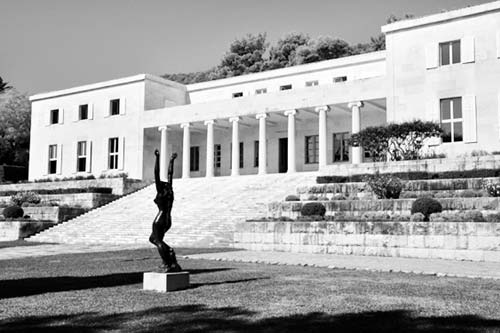
 Self-Guided Tour: Each work is labeled, but there’s very little description otherwise (and the 80-kn guidebook is overkill for most visitors). This tour will help you navigate the highlights. Before you begin, read the sidebar (see here) for background on Meštrović’s life; while the collection is presented thematically rather than chronologically, knowing the artist’s journey helps to make sense of what you’ll see.
Self-Guided Tour: Each work is labeled, but there’s very little description otherwise (and the 80-kn guidebook is overkill for most visitors). This tour will help you navigate the highlights. Before you begin, read the sidebar (see here) for background on Meštrović’s life; while the collection is presented thematically rather than chronologically, knowing the artist’s journey helps to make sense of what you’ll see.
After buying your ticket (and confirming the time for your return bus to the Old Town—likely at :10 past the hour), climb the stairs toward Meštrović’s house, pausing in the garden to admire a smattering of sculptures. On the right, see Persephone reaching skyward for freedom—an idea that came to Meštrović while he was imprisoned by the Ustaše in World War II. Beyond her, you’ll see Cyclops struggling to hurl a giant shot put—in keeping with Meštrović’s theme of the struggles of great men. Tucked behind the trees nearby is an eagle, which was a study for a mountaintop monument honoring one great man in particular, the Montenegrin King Petar II Petrović-Njegoš (see here). To the left as you face the building is a statue of a woman playing a lute, and reliefs of women playing a lute and harp flank the door of the villa. Much as he enjoyed depicting the travails of men, Meštrović also often sculpted women serenely engaging in music.
Go up another set of stairs to reach the Entrance Hall. The sculptures here evoke some of Michelangelo’s nudes and were fittingly carved from that great sculptor’s favorite medium: Carrara marble. The head of a woman glancing pensively out a window is Meštrović’s second wife, Olga, who was one of his favorite models. Notice the smaller black sculptures by the two staircases: on the left, representing birth, and on the right, representing death—Meštrović strove to capture the full range of human experience in his work.
Go to the left to find a maternal pyramid of love called Madonna and Children. While the woman is clearly garbed in the head scarf of the Virgin Mary, she cradles not one, but two children; these are Olga and Meštrović’s first two kids.
Now enter the Dining Room at the end of the main floor. This is the most intimate space in the villa—the only room that still feels even a little bit lived in—and is decorated with more sculptures of Meštrović and his family. Entering, go straight ahead to the windows and do a clockwise loop around the room. First look for the self-portrait bust of Meštrović and the bust of a woman in a traditional Dalmatian head scarf—this is Meštrović’s mother, another one of his favorite models. Notice that the two giant caryatids carved from Dalmatian stone (embedded with fragments of seashells) are also clad in this traditional garb. On the wall to the right of the fireplace, you’ll see two painted portraits of Meštrović—one as a young man (painted by his contemporary, Vlaho Bukovac—see here), and another shortly before his death. Other busts in the room depict Meštrović’s children. A painting of the Last Supper hangs in virtually every Dalmatian dining room, and Meštrović’s is no exception—he painted this version himself, on wood. He also designed the furniture in this room.
Now climb the stairs. On the landing, look for a large bronze relief panel called My People’s Artist. The old man and the young boy are linked by the gusle, a traditional Balkan stringed instrument. Here, Meštrović uses the gusle to represent the oral transmission of history (and specifically, the story of the pivotal Battle of Kosovo in 1389, a date etched into the minds of all Yugoslavs, particularly Serbs). Much as Meštrović dresses his women in traditional peasant clothes, he deeply believes in the regeneration of culture and customs over time. Meštrović’s detailed drawings in this room—including some inspired by Dante’s Divine Comedy—are worth a look.
Next, turn right into the Secession Room. Two of the finest works in this room—Little Girl Singing and The Katunarić Family—show the influence of Meštrović’s contemporary, Rodin: smoothed rather than angular features, which make the final product less strictly lifelike, but also more expressive and visually pleasing. Other pieces in this room include several small studies for larger statues, some of which were never completed.
Pass through the room of drawings into the Long Hall, lined with life-size figures and a view terrace. The Vestal Virgin, sitting with her knees apart and feet together, is demonstrating a favorite pose of Meštrović’s. And, once again, we see women finding solace and joy in music: dancing (while playfully tossing her hair), playing a lute, and so on. For contrast, look at the facing wall to see sketches of male nudes struggling. Step out onto the terrace to enjoy the Dalmatian views that inspired the artist.
At the end of the hall—past another small landing with drawings—is the Study Room, filled with miniature sculptures Meštrović created to prepare for larger-scale works: Moses, Prometheus (the figure tied to a rock, to be eaten by birds for eternity), and Cyclops (a large version of which we saw outside). Notice the small study of Job, then go into the small side-room to see the much larger final version.
One of Meštrović’s most powerful works, Job—howling with an agony verging on insanity—was carved by the artist in exile, as his country was turned upside-down by World War II. Like Picasso’s Guernica, it’s a silent scream against the inanity of war. The curator has intentionally placed it in a separate room to emphasize the feeling of alienation. Meštrović sketched his inspiration for this piece (displayed on the wall) while he was imprisoned by the Ustaše.
Head down the stairs and make a U-turn left into the Sacral Room. Meštrović was very religious, and here you can see some of his many works depicting biblical figures. The giant, wood-carved Adam and Eve dominate the room. Also notice the wood-carved relief panels of Merry Angels and Grieving Angels. (These are similar to the panels you’ll see at the Kaštelet Chapel down the road.) Smaller statues around the room include four evangelists (Matthew, John, and two Lukes—but no Mark), Moses, a pietà, and both bronze and wooden heads of Christ.
The smaller side-room displays another of the gallery’s highlights: the quietly poignant Roman Pietà. Meštrović follows the classical pyramid form, with Joseph of Arimathea (top), Mary (left), and Mary Magdalene (right) surrounding the limp body of Christ. But the harmony is broken by the painful angles of the mourning faces. Also notice how Jesus’ oversized, ruined body drags down those trying to support his dead weight; if he stood up, he’d be towering over all of them. For Meštrović, Christ’s suffering was personal: the women wear those traditional Dalmatian head scarves, the features of Joseph are a self-portrait, and Mary Magdalene is modeled after Meštrović’s daughter Marija. This sculpture is plaster; there’s a bronze version at the Vatican and a marble one on the campus of The University of Notre Dame in the US.
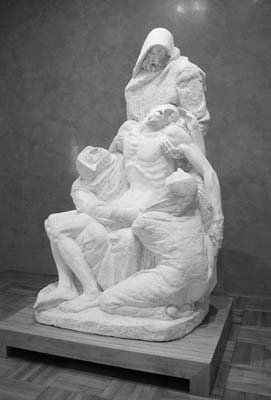
To reach the last part of the Meštrović experience, head down the stairs to the road, cross the street, turn right, and walk about five minutes. You’ll see the low-profile entrance to the chapel on the left, through a doorway marked 39, in an olive grove.
If you enjoy the gallery, don’t miss the nearby Kaštelet Chapel (“Chapel of the Holy Cross”). Meštrović bought this 16th-century fortified palace to display his 28 wood reliefs of Jesus’ life. You can see how Meštrović’s style changed over time, as he carved these over a nearly 30-year span, completing the last 12 when he was in the US. (However, note that he didn’t carve the reliefs in chronological order; the ticket office sells a booklet identifying the topic and year for each one.) While the earlier pieces are well-composed and powerful, the later ones seem more hastily done, as Meštrović rushed to complete his opus. Work clockwise around the room, tracing the life of Christ. Notice that some of the Passion scenes are out of order (a side-effect of Meštrović’s nonlinear schedule). The beautiful pietà back near the entrance still shows some of the original surface of the wood, demonstrating the skill required to create depth and emotion in just a few inches of medium. Dominating the chapel is an extremely powerful wooden crucifix, with Christ’s arms, legs, fingers, and toes bent at unnatural angles—a typically expressionistic flair Meštrović used to exaggerate suffering.
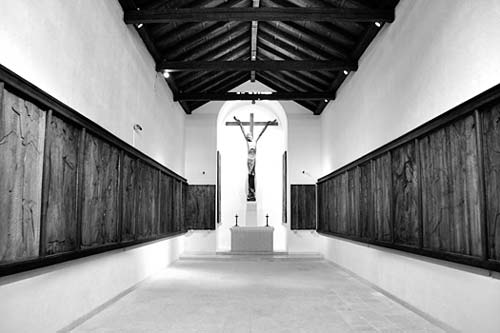
This huge, hilly, and relatively undeveloped spit of parkland—improbably located right next to Split’s Old Town—feels like a chunk of Dalmatian island wilderness, a stone’s throw from the big city. With out-of-the-way beaches and miles of hiking trails, the Marjan (MAR-yahn) Peninsula is where residents go to relax; most people here seem to have their favorite hidden paths and beach coves, so ask around for tips.
From the Šperun neighborhood at the west end of the Old Town, you can hike to various lookout points. The best views are from the lowest point. If you’re in shape, figure about an hour to hike to the top viewpoint, then another 45 minutes back down.
Start by climbing the stairs past the recommended Šperun Restaurant, and continue straight up Senjska ulica. Follow the stairs all the way up for 10-15 steep minutes to reach a spectacular view terrace (with sweeping vistas over Split’s Old Town), next to a little café.
If you like, you can keep ascending for more good views (though you can’t really see the Old Town beyond here). To continue on, curl around past the restaurant (following signs for Crkva sv. Nikole and Sedlo) and follow the steep pathway up, passing the fenced-in park on your right. Soon you’ll reach the small chapel of St. Nicholas. Just behind it, find the steps up and to the right (look for Marjanske Skale signs). At the top of these stairs is Split’s very humble zoo. From here, a broad path cuts through the woods, with smaller paths branching off downhill. For the highest viewpoint, follow signs for Sedlo and hike up the steps to the terrace. This top-of-the-world perch offers a 360-degree panorama of Split’s urban sprawl, receding layers of jagged and majestic mountains, offshore islands, and the bay behind the Marjan peninsula (but little in the way of Old Town views).
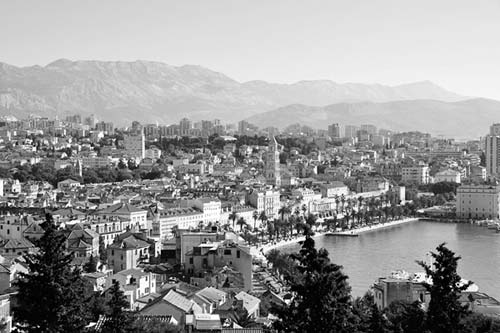
It’s easiest to go back down the way you came. But for a longer hike, continue down the stairs at the far end of the view terrace, and follow signs for Crkva sv. Jere. This path takes you along the length of the peninsula, mostly through trees (read: no views). A series of switchbacks leads back down to the main road running along the perimeter of Marjan; from here, you can turn left to get back to town or right for an even longer walk around the far end of Marjan.
The peninsula also has a pair of good beaches (Ježinac and Bene, described next).
Since it’s more of a big city than a resort, Split’s beaches aren’t as scenic (and the water not as clear) as small towns elsewhere along the coast. Save your Split time for big-city sights and culture, and hit the beach in smaller towns. However, if the weather’s great and you want to go for a dip, here are a few ideas.
The beach that’s most popular—and crowded—is Bačvice, in a pebbly cove just a short walk east of the main ferry terminal. As it’s very shallow, it’s especially popular with kids. This means it can be unpleasantly crowded when the weather’s good. After dark, it becomes a hopping meat-market nightlife zone for older “kids.”
You’ll find less crowded beaches just to the east of Bačvice. Each cove has its own little swimming zone; the fourth cove over, called Trstenik, is perhaps the most inviting. A pebbly beach—with free access—flanks the big deck in front of the Radisson Hotel, where you can rent a chair (100 kn), buy a drink at the bar, and use the free showers.
Or head in the other direction to Marjan, the peninsular city park, which is ringed with several sunbathing beaches. Along the southern edge of Marjan, just below the Meštrović Gallery, is a rocky but more local-feeling and less crowded beach called Ježinac (Croatian for “sea urchin”...be sure to wear water shoes). Bene Beach is along the northern edge of Marjan—so it offers more shade. You can get to Bene Beach by bus #12 (the same one that goes to the Meštrović Gallery), tourist train (described earlier, under “Getting Around Split”), bike, or foot (about a 45-minute walk from the Old Town).
Every night, the sea of Croatian humanity laps at the walls of Diocletian’s Palace along the town’s pedestrian promenade. Choose a bench and watch life go by, or enjoy a drink at one of the many outdoor cafés. Live music (funded by the tourist board) enlivens the Riva nightly through the summer (June-mid-Sept).
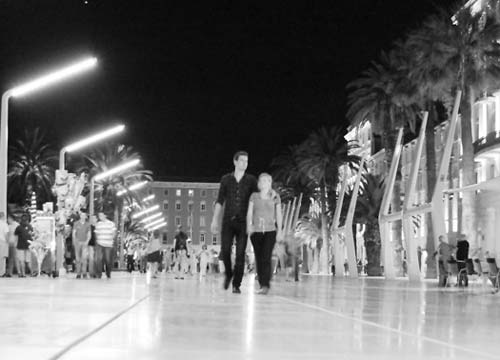
The labyrinthine lanes of the Old Town are packed with mostly interchangeable bars and cafés featuring pleasant tables crammed between ancient stone buildings under a starry Croatian sky. Even if you’re not interested in drinking, make a point to wander some of these areas after dark just to people-watch and take in the hubbub in these otherwise hidden pockets. If you’re staying in the Old Town, you’ll hear bar-goers late into the night. If you can’t beat ’em, join ’em. One way is to simply lose yourself in the twisty lanes by following the music and the sound of socializing Croatians to the spot you like best. Or, if you prefer a little direction to your ramblings, explore the following neighborhoods. Note that, while each of the bars listed here has an interior, there’s little reason to sit anywhere but under the open sky. Prices and menus are similar at most places (beer, wine, cocktails, coffee drinks); ordering something simply gives you an excuse to sit in a gorgeous outdoor space, nurse a drink, and focus on your travel partner. The action at these places really gets rolling around 22:00 and peaks around 23:00 or 24:00. Bars are supposed to close their outdoor seating areas at 2:00.
On the Peristyle: The obvious choice is right on the main square of the Old Town, Diocletian’s former entry hall. All day long, the Peristyle steps serve as makeshift café tables for the bar called Luxor, with red cushions and small tables scattered along the steps. If you sit on a cushion, you’re expected to order a drink (but you can sit or stand elsewhere for free). In the evening—as twilight encroaches and floodlights transform the square into one of the most atmospheric public spaces in Europe—live music breaks out (generally starting between 20:00 and 21:00 and continuing until around midnight). The smooth marble tiles of the Peristyle—worn to a slippery sheen by two millennia of visitors—becomes a dance floor, as people salsa, foxtrot, or pop-and-lock their way around the majestic space. Where else can you cut a rug in the grand entry hall of a Roman palace?
Majstora Jurja: This street, which runs along the north edge of Diocletian’s Palace (just inside the wall), is lined with a mellow gaggle of low-key hangouts. Some mood music plays, but the soundtrack here is mostly chatting, laughing, and flirting. West of the Golden Gate, the lineup of café/bars includes the nondescript Kala and Mosquito. Two better options are nearby: Up the side street at Dominisova 9, Galerija has the classiest atmosphere, with an upscale-feeling (but not stuffy), gallery-like ambience and a display case of cakes. A bit farther along Majstora Jurja is Teak, with a namesake woody interior that feels almost distinguished. East of the Golden Gate is a tamer zone, with the soccer-themed Mali Flek and then the Red Room, filling a large square with tables.
“Slavija Square”: This is my own nickname for the tight, stepped area that’s squeezed in front of Hotel Slavija, near Radić Brothers Square (Trg Braće Radića; from the square’s statue of Marulić, enter the Old Town and bear right, following the beat). This area is more youthful and rowdy, with throbbing techno music and cocktails that flow freely. Clambering up the steps are several bars, including the mellow Figa and the hip Fluid, with predictable thumpa-thumpa atmosphere. Near the top of the stairs, the engagingly scruffy Split Circus boasts magic-marker walls and several varieties of rakija, the ubiquitous Balkan firewater. A few steps beyond, through the enclosed courtyard on the right, Ghetto has a mellower sailors’ bordello-theme interior, with heart-shaped chairs, red velvet, and vivid graffiti.
Behind the Loggia: For the youngest, trendiest scene in the Old Town, head for the zone locals call Iza Lođa (“Behind the Loggia”). From the grand People’s Square, follow the beat behind the former City Hall loggia to discover a well-dressed meat market populated by sleazy young men and tipsy American girls determined to make bad decisions. The main magnet here is the standing-room-only Gaga, with a pounding dance beat, indoor and outdoor bar areas, and a laser-light show on the ancient stones above. At the far end of the little square, like a mellow grandparent observing the rowdy younger generation, is La Linea (which locals call simply “taverna”)—an old sailors’ pub decorated with nautical flags.
Other Areas: The large square at the top of Marmontova, just before the Zara store, is crammed with tables belonging to a half-dozen identical-feeling cafés. And with the arrival of the recommended Bajamonti café, Trg Republike (the grand Napoleonic square just west of the Riva) could also become a happening nightlife option.
This family-friendly beach by day becomes a throbbing party area for young locals late at night. Since all Old Town bars have to close by 2:00 in the morning, night owls hike on over to the Bačvice crescent of clubs. The three-floor club complex is a cacophony of music, with the beat of one club melting into the next—all with breezy terraces overlooking the harbor.
Split has more and more sleeping options every year, as little guest houses frequently pop up. But even with the abundance of beds, prices can be high in this big city. Split also suffers from perhaps the worst nighttime noise of any destination in this book—bring earplugs, and always ask for a quiet room (if possible). If you’re on your own for breakfast, see my suggestions on here.
These good values are within a five-minute walk of the Old Town. They’re nearly as convenient as the Old Town options, but cheaper. Of these places, only Hotel Luxe has a full-time reception desk; for the others, call ahead to arrange your arrival time.
The Lučac neighborhood—which lines up along the busy street called Kralja Zvonimira—feels urban and a bit gritty, but it’s handy to the Old Town. You’ll find more Old World atmosphere on Petrova street, a block below the main road.
$$$ Hotel Luxe, a sleek, minimalist hotel with 30 upscale-mod rooms, is a comfy splurge that combines a fine location (near the Old Town) with sea views—rare in this city. While it fronts a dreary, busy urban street, all of its rooms face the quieter back side, and most have views over the harbor (non-view “classic” Db-€165/€115/€85, partial-view Db-€195/€140/€100, bigger “comfort” Db with view and small balcony-€245/€165/€115, “superior” Db with view and big balcony-€315/€195/€135, Sb in any category is €15 less, cheaper Nov-Feb, air-con, elevator, free Wi-Fi, spa with small gym and Jacuzzi, free parking behind hotel, Kralja Zvonimira 6, tel. 021/314-444, www.hotelluxesplit.com, hotelluxe@hotelluxesplit.com).
$$$ Villa Diana has six pleasant, though pricey and small, rooms in a stone house over a restaurant (Sb-€109/€90/€66, Db-€149/€116/€80, Tb-€170/€129/€93, rates vary with demand—email them directly for better rates, pricier apartment also available, cheaper Nov-March, air-con, free Wi-Fi, free parking, next door to Villa Ana at Kuzmanića 3—see directions in next listing, tel. 021/482-460, www.villadiana.hr, info@villadiana.hr).
$$ Villa Ana, my sentimental favorite in Split, has five modern, comfortable rooms in a smart little freestanding stone house (Sb-€80, Db-€100, Tb-€115, can be cheaper at last minute in shoulder season, roughly €20 less Nov-March, includes breakfast, air-con, free Wi-Fi, reception open sporadically 7:00-22:00, may be closed mid-Dec-mid-Jan, a few tight free parking spots out front; 2 long blocks east of Old Town up busy Kralja Zvonimira, follow the driveway-like lane opposite the lonely skyscraper to Vrh Lučac 16; if using GPS, enter the address Kralja Zvonimira 14 to get close; tel. 021/482-715, www.villaana-split.hr, info@villaana-split.hr, Danijel Bilobrk and helpful Branka).
$ Dioclecijan Apartments, run by Tomislav Skalić and his wife Ivana, has two small rooms and one apartment in a pleasant local neighborhood. The decor is a tasteful mix of new and traditional. As the owners live off-site, carefully arrange a meeting time in advance (Db-€55/€40, apartment-€80/€65, lower price is for Oct-March, 1-night stays cost €5 more in rooms or €10 more in apartment, prices soft, cash only, no breakfast, air-con, free Wi-Fi, Petrova 19, Tomislav’s mobile 091-537-1826, Ivana’s mobile 091-536-7486, tskalic1976@gmail.com).
In addition to hosting the following accommodations, the atmospheric Varoš neighborhood—with twisty lanes climbing up toward the forested peak of the Marjan peninsula—is also home to several recommended eateries and the self-service Modrulj Launderette.
$$ Villa Matejuška, run by kind Andreja, has six apartments with old-fashioned beams and stone walls on a tight lane just up from the fishermen’s port (Db-€110-135/€80-105/€60-85, price depends on size, cash only, no extra charge for 1-night stays, no breakfast, air-con, free Wi-Fi, Tomića Stine 3, mobile 098-222-822, www.villamatejuska.hr, villamatejuska93@gmail.com). A second branch, $$ Villa Urbi et Orbi, has six cheaper units a steep five-minute hike up the street (Db-€100-110/€70-80/€50-60, price depends on size, 4-person apartment-€170/€140/€120, same amenities as Villa Matejuška; from Villa Matejuška, continue up Senjska, head straight up the stairs, then turn right on Šenoina to #2; mobile 099-734-2777, www.villaurbietorbi.hr, villaurbietorbi97@gmail.com).
$$ Villa Varoš, run with class by Croatian-American Joanne Ðonlić and her son Jure, has eight rooms and an apartment (with its own terrace) on a residential lane just beyond the restaurant-lined Šperun street. Thin walls and echoey halls can make for a noisy night (Db-€80/€65, Tb-€85/€70, apartment-€120/€90, lower prices are for Oct-March, rates include tax, no breakfast, air-con, stairs with no elevator, free Wi-Fi, Miljenka Smoje 1, tel. 021/483-469, Joanne’s mobile 098-469-681, Jure’s mobile 098-229-408, www.villavaros.hr, joanne.d.o.o@st.t-com.hr).
While the Old Town is convenient and atmospheric, it’s also a happening nightlife zone, so you’re likely to encounter some noise (especially on weekends). Old Town bars can stay open until 2:00 in the morning...earplugs are essential.
$$$ Marmont Hotel is an enjoyable oasis offering four-star comfort, with 21 classy rooms in a quiet corner of the Old Town. The slight aroma you may notice is from the fish market, just around the corner (standard Sb-€195/€150/€120, superior Sb-€245/€190/€155, Db-€220/€180/€140, superior Db-€270/€220/€180, pricier “deluxe” rooms also available, air-con, elevator, free Wi-Fi, sun terrace, Zadarska 13, tel. 021/308-060, www.marmonthotel.com, booking@marmonthotel.com).
$$$ Palača Judita is a splurge, designed for people who are willing to pay extra for good service and serenity in a cozy B&B atmosphere (rather than a traditional hotel). Its eight rooms are beautifully located in a 16th-century Renaissance palace on the appealing “People’s Square,” with solid windows to help block out the after-hours ruckus (Db-€269-319/€169-229/€99-139; price varies dramatically depending on size, amenities, and when you book; includes breakfast, air-con, free Wi-Fi, free parking and porter service, Narodni Trg 4, tel. 021/420-220, www.juditapalace.com, booking@juditapalace.com).
$$$ Hotel Vestibul Palace is the swankiest spot in Split’s Old Town, with modern decor in an old shell. Tucked in a corner just behind the entry vestibule on the upper level of Diocletian’s Palace, this plush place offers seven rooms with maximum style and service for maximum prices. Throughout the day, you’ll hear the harmonious voices of the klapa singers echoing up from the vestibule below; they take their breaks at the hotel’s outdoor tables. Sleep here only if you value location, comfort, and service without regard for the price tag (Sb-€355/€255/€140, small “standard” Db-€375/€275/€160, superior Db-€475/€380/€200, pricier suites also available, air-con, no elevator, free guest computer and Wi-Fi, valet parking, Iza Vestibula 4, tel. 021/329-329, www.vestibulpalace.com, info@vestibulpalace.com). They also have four more rooms in a nearby annex, called Villa Vestibul, and plan even more in a new property just outside the Old Town.
$$$ Hotel Peristil has 12 classy rooms over a restaurant just steps from the couldn’t-be-more-central square of the same name. Run by the Caktaš family, it’s homey and convenient, if pricey (Sb-€135/€110/€95, Db-€160/€135/€120, extra bed-€35, air-con, stairs with no elevator, free Wi-Fi, some noise from nearby bars, just behind TI and inside the Silver Gate at Poljana Kraljice Jelene 5, tel. 021/329-070, www.hotelperistil.com, booking@hotelperistil.com).
$$ Kaleta Apartments, run by the Raić family, consists of several tastefully decorated apartments spread across two buildings. Two stylish, modern apartments are squeezed between cafés along a tight alley in a lively area at the back of the Old Town (the good windows do a heroic job of keeping noise to a minimum). Their other three units, including a larger one with a couch and eat-in space, share a common lounge in a quieter building a few blocks away, near the People’s Square (Db-€75-90, €60-80 in Oct-May, price depends on size of room, cash only, air-con, free guest computer and Wi-Fi, Majstora Jurja 4, mobile 099-509-4299, www.kaletaapartments.com, kaletaapartments@email.t-com.hr).
$$ Split Apartment Croatia, run by go-getter Nikša, is an agency with a line on apartments around Split. Nikša rents three of his own rooms, near the People’s Square (Db-€75/€55/€40, no breakfast, air-con, free Wi-Fi). He can also arrange a room for you elsewhere for similar prices (you pay him 20 percent, then the rest to the owner, cash only; his office at Majstora Jurja 4 serves as a sort of reception desk, offering free coffee and guest computer; mobile 091-390-9416, www.split-apartment.com, info@split-apartment.com). Nikša also has five elegant, nicely equipped rooms just north of the Old Town in a building called Priuli Luxury Rooms (Db-€110/€85/€50, Sinjska 1, tel. 021/341-083, www.priulisplit.com).
$ Sobe “Base” has three good rooms in the Old Town. Tina and her dad, retired ship’s captain Ivo, offer many amenities unusual for this price range, including free Wi-Fi and Internet terminals in each room. You can’t be more central: All of the colorful rooms—located over a gift shop—overlook the front steps of the cute little Jupiter’s Temple. Although it’s in the midst of some bustling bar action, the double-paned windows do their darnedest to provide reasonable peace; earplugs help, too (Db-€80/€70, lower price is for Sept-June, cash only, no extra charge for 1- or 2-night stays, no breakfast, clearly communicate your arrival time, air-con, Kraj Svetog Ivana 3, tel. 021/317-375, mobile 098-361-387, www.base-rooms.com, mail@base-rooms.com).
$ Goli & Bosi Hostel (“Nude and Barefoot”) is a design hostel filling an old shopping mall in a hidden square in Split’s Old Town, just off of Marmontova. It’s big (135 beds in 25 rooms), industrial-strength, and unabashedly stylish. The neon-yellow halls (inspired by the sulfur springs that lured Diocletian here)—scrawled with important dates from Croatian history—give way to white, minimalist rooms. It’s expensive (the private rooms are downright overpriced), but it’s stylish and offers lots of fun amenities, including shared view balconies, an “auditorium” for watching movies, a restaurant out front, and lots of parties (bunk in 4- to 8-bed dorm-€32/€28/€25, small Sb-€90/€72/€60, small Db-€105/€90/€82, larger “premium” Db-€150/€130, cheaper mid-Oct-mid-April, private rooms include breakfast but dorm dwellers pay €5 extra, elevator, air-con, free Wi-Fi, tries to be soundproof in sleeping areas, Morpurgova Poljana 2, tel. 021/510-999, www.golibosi.com, info@golibosi.com).
I’ve concentrated my listings inside Split’s Old Town and within the adjacent Varoš district, just a couple of blocks west, which has several characteristic konobas (traditional restaurants). Reservations are wise, especially for dinner.
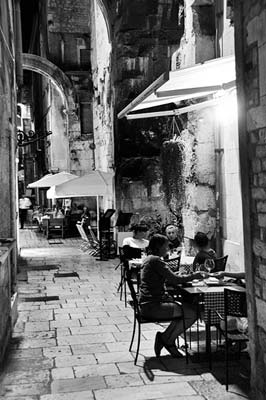
(See “Split Hotels & Restaurants” map, here.)
Šperun Restaurant has a classy, cozy Old World ambience and a passion for good Dalmatian food. Owner Damir Banović (with the help of his animated dad, Zdravko) serves a mix of Croatian and “eclectic Mediterranean,” specializing in seafood. A “buffet” table of antipasti (starters) in the lower dining room shows you what you’re getting, so you can select your ideal meal (not self-service—order from the waiter). This place distinguishes itself by offering a warm welcome and good food for reasonable prices (40-90-kn pastas, 60-130-kn meat and seafood dishes, daily 9:00-23:00—but likely closed Sun Nov-March, air-con, a few sidewalk tables, reservations wise in summer, Šperun 3, tel. 021/346-999). Their annex across the street, Bistrot Šperun Deva, has a simpler and cheaper menu, lots of outdoor seating, and a handy à la carte breakfast for soba-dwellers (20-50-kn salads, 60-75-kn main courses, daily 8:00-23:00—except closed 13:00-18:00 Mon-Tue, closed off-season, Šperun 2).
Konoba Matejuška offers charm, good food, and fair prices in a cozy, mellow, five-table cellar. This place is tiny and justifiably popular, so reserve at least a day before (60-80-kn starters, 50-150-kn main courses, daily 12:00-23:00, Tomića Stine 3, tel. 021/355-152).
Konoba Varoš, though old-school, bigger, and more impersonal than others listed here, is beloved by natives and tourists alike for its great food. Serious waiters serve a wide range of Croatian cooking (including pastas, seafood, and meat dishes) under droopy fishnets in a slightly gloomy throwback interior (55-85-kn pastas, 60-130-kn main courses, daily 9:00-24:00, lots of groups, reservations smart, Ban Mladenova 7, tel. 021/396-138).
Smoothies and Fruit Juices: For a healthier energy boost, head for Tonik Juice Bar, run by Croat-Aussie Stefanie. Select from the diverse menu of smoothies and juice combos (20-40 kn). In summer, they also serve light meals (35-kn sandwiches, 30-kn muesli for breakfast, June-Sept daily 7:00-22:00, shoulder season daily 8:00-21:00, closed Nov-March, near the launderette and Šperun street restaurants at Ban Mladenova 5, mobile 098-641-376).
(See “Split Hotels & Restaurants” map, here.)
Trattoria Bajamont, not to be confused with Bajamonti (listed below), is buried on a narrow lane deep in the Old Town. They offer unpretentious, affordable Dalmatian home cooking with an emphasis on fish. The handwritten menu informs you of the day’s options—all fresh from the market. In this tight, casual, and cozy eatery, the busy kitchen and seven tables are all crammed into a single room (with more tables on the alley outside). Because the place can be crowded, you may have to share your table—and be prepared for the service to be chaotic and a bit quirky (90-120-kn pastas, 90-150-kn fish dishes, cash only, daily 8:00-24:00—but closed Sun outside peak season, Bajamontijeva 3, tel. 021/355-356).
Apetit serves up traditional Dalmatian cuisine in an appealingly modern, second-floor dining room. As there’s no outdoor seating, this is a good bad-weather option (60-85-kn pastas, 60-125-kn main courses; 90-kn daily special includes soup, salad, and main dish; lots of groups, daily 10:00-24:00, Šubićeva 5, tel. 021/332-549).
Bajamonti sits regally at the top of Split’s beautiful, arcaded square, Trg Republike, just off the west end of the Riva. This place brings a certain grand-café elegance to Split’s otherwise rustic-konoba-heavy dining scene. The interior is classy, with checkerboard-tiled, split-level elegance, but the best seating is on the grand square out front, facing the sea. The food is pricey, with an emphasis on fish (90-120-kn pastas, 120-170-kn main courses, 75-95-kn lunches, daily 7:30-24:00, Trg Republike 1, tel. 021/341-033).
Uje Oilbar is the flagship restaurant of Croatia’s popular chain of upscale olive-oil boutiques. Tucked away in a hidden corner of the Old Town, it serves simple plates and boards of Dalmatian pršut (prosciutto), cheeses, olives, and, of course, olive oils—50 different types. The menu is short, and it feels more like a big snack than a hearty meal; to assemble a filling meal, you’ll run up quite a bill. But the rustic-mod interior, pleasant (if cramped) outdoor seating, and refreshingly good-quality local flavors can make a light meal here worthwhile (35-65-kn olive-oil tastings, 70-100-kn small plates and taster boards, daily 12:00-24:00, Dominisova 3, mobile 095-200-8008).
Maslina (“Olive”), an unpretentious family-run spot filled with locals, hides behind a shopping mall on the busy Marmontova pedestrian street. They serve a wide range of 45-70-kn pizzas and pastas, plus 70-120-kn meat and fish dishes (Tue-Sat 11:00-24:00, Sun-Mon 12:00-24:00, Teutina 1A, tel. 021/314-988, Pezo family). It’s virtually impossible to find on your own, so follow these directions carefully: Approaching the top of Marmontova from the harbor, look for the low-profile archway on the left beyond the café tables (just before the big Zara store). Walk along the skinny path between the building and the old wall to reach the restaurant.
Pizzerias: Ristorante Pizzeria Galija, at the west end of the Old Town, has a boisterous local following and good wood-fired pizzas, pastas, and salads. They have a cozy interior and a terrace (40-75 kn, Mon-Sat 9:00-24:00, Sun 12:00-24:00, air-con, just a block off of Marmontova at Tončićeva 12, tel. 021/347-932; the recommended Hajduk ice-cream shop is nearby). Zlatna Vrata (“Golden Gate”), right in the Old Town, offers wood-fired pizzas and pasta dishes. The food and interior are nothing special, but there’s wonderful outdoor seating in a tingle-worthy Gothic courtyard with pointy arches and lots of pillars. They plan to start serving a more extensive and expensive menu in the near future, so prices may increase (50-75 kn, Mon-Sat 7:00-24:00, closed Sun, just inside the Golden Gate and—as you face outside—up the skinny alley to the left, on Majstora Jurja, tel. 021/345-015).
Take-Away: Fast Food None (“Grandma’s”) is a stand-up or take-away pizza joint handy for a quick bite in the Old Town. In addition to pizzas and bruschettas with various toppings, they serve up a pair of traditional pizza-like specialties (with crust on bottom and top, like a filled pizza): viška pogača, with tomatoes, onion, and anchovy; and soparnik, with a thin layer of spinach, onion, and olive oil. They can also make you a grilled sandwich—just point to what you want (10-30 kn, Mon-Sat 7:00-23:00, closed Sun, just outside Diocletian’s Palace on the skinny street that runs along the wall at Bosanska 4, tel. 021/347-252). Kantun Paulina (“Paulina’s Corner”) is a local favorite for take-away ćevapčići—Balkan grilled meats (17-20 kn, Mon-Sat 8:30-24:00, Sun 10:00-24:00, Matošića 1). For descriptions of your options, see the “Balkan Flavors” sidebar on here.
Wine Bar: Paradox Wine & Cheese Bar, in an unassuming urban zone behind the National Theater, offers an inviting opportunity to sample some local wines. Their well-structured menu lists 120 wines, 50 of which are available by the glass (20-120-kn glasses, 100-800-kn bottles). Sit either in the cozy old-meets-modern interior or out on the terrace (also 25-40-kn light bites, including cheese and prosciutto, daily 9:00-24:00, Dubrovačka 18, mobile 099-817-0711).
Breakfast: The budget choice is to simply buy some pastries at a bakery and eat them on a harborfront bench. Hotel Peristil serves an all-you-can-eat breakfast—including eggs—to non-guests for 60 kn (daily 7:00-11:00); the adjacent Duje Restaurant, just behind the cathedral, has a similar deal. For a cheap alternative, head over to the Matejuška fishermen’s port, where Leut restaurant serves a 30-45-kn breakfast on their terrace (from 9:30). Several of my recommended restaurants also offer breakfast.
Gelato: Split has several spots for delicious ice cream (sladoled). Most ice-cream parlors (kuća sladoleda) are open daily 8:00-24:00. Natives recommend Hajduk, named for Split’s soccer team; ask them to dip your cone in milk chocolate for no extra charge (a block off the main Marmontova pedestrian drag, around the corner from Pizzeria Galija at Matošićeva 4).
As the transport hub for the Dalmatian Coast, Split has good boat connections to nearly anywhere you want to go. The fast passenger catamarans dock close to the Old Town: the Krilo catamaran uses dock #11 (a.k.a. Gat Sv. Petra), which is along the pier halfway between the main ferry terminal and the Old Town; and the Jadrolinija catamaran usually arrives and departs at the handy Obala Lazareta embankment just in front of the Old Town (although it may sometimes use dock #11 instead—ask when you buy your ticket). Big car ferries can arrive or depart from all along the harbor (electronic boards display which dock each boat leaves from). Note that these locations sometimes change according to boat traffic.
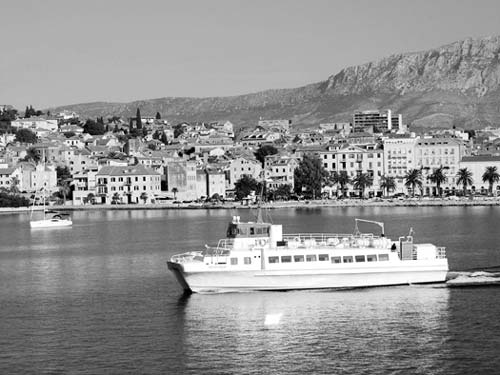
Note: The following boat information is subject to change—always confirm before you make your plans. To check Jadrolinija schedules, see www.jadrolinija.hr; for Krilo catamaran schedules, see www.krilo.hr. Or drop by Split’s helpful Jadrolinija boat ticket office, in the main ferry terminal (open 24/7 in summer, daily 5:30-24:00 off-season, tel. 021/338-333).
If you want to take a fast passenger catamaran (either Krilo or Jadrolinija), buy your tickets in advance.
Krilo tickets can be bought anytime; in peak season, it’s smart to buy yours at least the day before your scheduled departure. Krilo tickets are sold only at the kiosk at its departure dock (#11; look for kiosk marked Kapetan Luka). Beginning in 2014, you may be able to buy Krilo tickets online; check www.krilo.hr.
Jadrolinija catamaran tickets are not sold until 6:00 in the morning on the day of departure. As these boats can sell out quickly in peak season, buy your tickets in the morning. Catamaran tickets—even for afternoon departures—can sell out by 8:30; to play it safe, line up by 8:00. Off-season, you can usually wait until 9:00 for morning departures, or until noon (or later) for afternoon departures. If your trip hinges on a specific boat, ask at the ticket desk the day before what time you should show up. For Jadrolinija catamarans, you can buy tickets at three locations: the kiosk on the parking island right in front of the Old Town; next to the Krilo kiosk alongside the harbor; and in the main terminal (if the kiosk near the Old Town has a long line, you could walk five minutes to the next one, where the wait is probably shorter).
If tickets do sell out, you’re not entirely out of luck. Each route is also operated by slower car ferries with unlimited room for walk-on passengers. The downside is that car ferries take longer and drop you off at ports that are not convenient to the main town on each island (Stari Grad on Hvar, Vela Luka on Korčula), requiring an additional bus trip to your final destination. The ticket-seller can advise you on alternatives.
If you’re a passenger walking onto a Jadrolinija car ferry, there’s no need to buy tickets in advance. (Tickets are sold at the same three locations noted above.) However, if you’re driving onto a car ferry, it’s smart to buy your tickets from one of the Jadrolinija kiosks mentioned above and line up early—ask locally for advice on your particular boat.
While I haven’t listed specific fares below, walk-on passage for both catamarans and ferries is quite affordable. The passenger fare on a trip from Split to Hvar or Korčula costs only around 35-60 kn, depending on the type of boat and season. For longer journeys (such as on the slow car ferry from Split to Dubrovnik or Rijeka), figure 100-150 kn.
Weather Disruptions: Catamarans are the quickest way to the islands, but they’re also the most susceptible to inclement weather. In very rough or windy weather, cancellations are possible (decisions are made a couple of hours before departure—ask at the ticket booth what time you should come back to check). In poor weather, the Krilo is more stable (and provides a more comfortable ride) than Jadrolinija’s catamaran; if you have an option, go with Krilo. If the catamarans aren’t running, look into taking the slower car ferries instead (which typically go in any weather).
Big Jadrolinija Car Ferries: Twice weekly in summer, these hulking boats make the long trip down the Dalmatian Coast, connecting key destinations. They leave Split early in the morning (at 7:30) and head south, stopping at Stari Grad on Hvar Island (20-minute bus ride from Hvar town; 1.75 hours; the catamarans described next are faster and take you right to Hvar town), Korčula town (6 hours; again, catamarans to Korčula island are faster), Sobra on Mljet Island (1.25-hour bus ride from the national park; 8.75 hours), and Dubrovnik (11 hours). You can also take a boat to Rijeka, on the northern Croatian coast, 4 hours by train from Zagreb and 2.75 hours by train from Ljubljana (2/week, June-Sept only, 11 hours overnight).
Other Boats to Hvar Island: To reach Hvar, ideally catch a boat heading to Hvar town, the most interesting part of the island. Two companies run speedy catamarans (50-60 minutes) from Split to Hvar town: Jadrolinija (June-Sept: 3/day, departing Split at 11:30, 15:00, and 17:00; Oct-May: 2/day, departing Split at 15:00 and 17:00; occasionally stops at Milna on Brač Island) and Krilo (May-Oct: departs Split daily at 9:30 and 18:00; a different catamaran, bound for Vis, stops at Hvar only on Tuesdays; these boats likely don’t run Nov-April, but confirm at www.krilo.hr—schedule has been in flux). You can also reach Hvar Island on the local car ferries from Split; these are frequent but take longer and are less convenient, since they take you to the town of Stari Grad, across the island and a 20-minute bus trip from Hvar town. On the other hand, these are the only way to get to Hvar in the morning—and a good backup plan if the 11:30 catamaran sells out, or if the catamaran stops running due to bad weather (7/day in summer, 3/day in winter, 1.75 hours).
Other Boats to Korčula Island: Many of the same boats that go to Hvar town continue on to Korčula Island. It’s most convenient to take the Jadrolinija catamaran, which brings you directly to Korčula town (departs Split 17:00 in summer, 16:00 in winter). Other boats leave you at Vela Luka, at the far end of the island from Korčula town (buses meet arriving boats to take passengers on the one-hour trip into Korčula town). These include other Jadrolinija catamaran departures (June-Sept: departs Split at 15:00, Oct-May: departs at 14:00, 2 hours). You can also take Jadrolinija’s slower local car ferries from Split to Vela Luka (1-2/day, 3 hours).
Each of the following routes is served by multiple companies, which charge slightly different rates. Always ask about the fastest option—which can save hours of bus time. It’s smart to arrive about 30 minutes before your bus departs to buy tickets (better yet, during peak season, come to the station to buy them earlier in the day). The generally English-speaking staff at Split’s bus station gives out handy little schedules for popular journeys. Bus info: www.ak-split.hr, toll tel. 060-327-777.
By Bus to: Zagreb (at least hourly, 5-8 hours depending on route), Dubrovnik (at least hourly, less off-season, 3.5-5 hours), Korčula (1 night bus leaves at 24:45 and arrives around 6:00), Trogir (1-2/hour, 30 minutes), Zadar (at least hourly, 3 hours), Mostar (7/day, 4-4.5 hours), Međugorje (4/day, 3.5 hours), Sarajevo (6/day in summer, 4/day in winter, 7.5-8 hours), Rijeka (7-10/day including some night buses, 6-8 hours). Zagreb-bound buses sometimes also stop at Plitvice (confirm with driver and ask him to stop at the national park entrance; about 7-8/day in summer—the best are the direct connections with Prijevoz Knežević, described on here; 4/day in winter, 4-6 hours).
From Split, trains go to Zagreb (2/day, 6.5 hours; 1 direct night train, 9 hours); in Zagreb, you can transfer to Ljubljana (4/day, 9 hours total). Train info: tel. 021/338-525 or toll tel. 060-333-444, www.hznet.hr.
Driving around the city center can be tricky—Split is split by its Old Town, which is welded to the harbor by the pedestrian-only Riva promenade. This means drivers needing to get 300 yards from one side of the Old Town to the other must drive about 15 minutes entirely around the center, which can be miserably clogged with traffic. A semicircular ring road and a tunnel under the Marjan peninsula help relieve the situation a bit.
Arriving in Split: Drivers are treated to the ugly side of Split as they approach town (don’t worry—it gets better). From the expressway, you’ll pass through an industrial zone, then curl through a few tunnels as you twist your way down into Split’s striking, bowl-like setting. While you’re still quite a distance from downtown, you’ll come to a fork where you’ll have to make a decision about which side of town you want to drive to (east or west); ask your hotel in advance for directions, and be ready for your turn. (While many hotels are individually signposted at the fork, it’s a long list and hard to read quickly as you zip past.)
At the main fork, turning to the right (marked with Centar signs) takes you to the west end of the Old Town, including the Varoš neighborhood. Or, if you continue straight (marked Trajekt—“ferry”), you’ll eventually reach other Centar signs and the east end of the Old Town, with the ferry terminal, the bus and train stations, and the Lučac neighborhood. You’ll pop out right at the southeast corner of Diocletian’s Palace (by the Green Market). For handy (but expensive) parking, when the road swings left to the ferry terminal, continue straight, and then turn right into a parking lot just outside the palace walls (10 kn/hour).
Connecting Split with Destinations to the North: Thanks to Croatia’s A-1 super-expressway, the road trip from Zagreb to Split takes less than five hours. You can leave Zagreb after an early dinner and arrive in Split before bedtime. If you’re heading north from Split, simply drive up out of the city’s bowl-like setting and follow signs to the A-1 expressway north (toward Zagreb; if you’re going to Plitvice, turn off at Otočac and drive east from there).
Connecting Split with Destinations to the South: If you’re heading to Dubrovnik, other Dalmatian Coast destinations, or Mostar—it’s a bit more complicated, as the expressway southbound from Split is only partially completed (to check the latest progress, see www.hac.hr or www.hak.hr). You have two options. The main coastal road twists slowly but scenically along some fantastic scenery, in an area dubbed the “Makarska Riviera.” (Along this road is the town of Drvenik, where you can take a ferry to Sućuraj on Hvar Island; from Sućuraj, a surprisingly long and twisty road traverses the length of the island to Hvar town. If you’re going to Hvar Island, taking a car ferry directly from Split to Stari Grad is much faster and less stressful.) Continuing south, you’ll wind up in the town of Ploče (described later).
To save some time, most travelers prefer to take the expressway part of the way. To do this, as you leave Split, follow blue expressway signs to Dubrovnik. You can take A-1 south as far as it goes; it cuts inland from the sea, running behind the tall coastal mountain range, near the Bosnian border. Construction on the A-1 expressway is ongoing, but you’ll likely be diverted to surface roads at least part of the way between Vrgorac and Ploče. (Note that if you’re headed to Mostar, the fastest way from here is to pass into Bosnia-Herzegovina just south of Vrgorac, at Veliki Prolog, then follow signs to Mostar from there.)
Ploče has a ferry that runs to the town of Trpanj, on the landward side of the Pelješac Peninsula—not far from Orebić, where another boat plods across to Korčula town. If you’re headed to Korčula and plan your timing to catch this ferry, it could save you some driving.
Just south of Ploče is the dramatic Neretva River Delta, a scenic and lush zone of farmland (described on here). This also marks the end of the A-1 expressway. Here you’ll hop on the main Dalmatian coastal road. Halfway along the delta, you’ll see the turnoff to Metković, the gateway town on the main, heavily touristed road between Croatia and Mostar.
South of the Neretva River Delta—after twisting up to a high perch overlooking the delta—is a border crossing. Here begins an odd little stretch of coastline that’s technically in Bosnia, around the town of Neum (for details on Neum—and the bridge Croatia is building to bypass it—see “A Bridge Too Far?” on here). Have your passport ready, but don’t panic—the border is generally a quick wave-through. After a few more miles, you’ll cross back into Croatia, and shortly come to a crossroads where, if you like, you can turn right and detour a few minutes to the impressively walled little villages of Ston and Mali Ston, at the base of the Pelješac Peninsula (all described on here). If you’re headed to Korčula, continue beyond Ston to the far end of the Pelješac Peninsula, where the ferry plods from Orebić to Dominče, near Korčula town.
After Ston, you’re less than an hour from Dubrovnik. Along the way, you’ll have fine views of Mljet and the Elaphite Islands. As you near Dubrovnik, you’ll pass through the town of Trsteno, which has a good arboretum (described on here). When you cross the giant, modern bridge, you’ll know Dubrovnik is just around the bend; for arrival tips, see here.
Two destinations are easy, worthwhile side-trips from Split: the small town of Trogir, and farther north, the swimmable waterfalls at Krka National Park.
Just 12 miles northwest of Split, across a giant bay, is Trogir, a tiny, medieval-architecture-packed town surrounded by water. This made-for-tourists village lacks the real-world heart and soul of Split, and it’s reminiscent of a dozen other Croatian coastal resort towns (Hvar and Korčula are bigger and better). But Trogir’s proximity to Split makes it appealing to yachters; the proud masts of tall ships line the harbor three deep. Although Trogir is nothing to jump ship for, it’s an easy day trip for those looking to get away from urban Split.
The easiest option in summer is to take the Bura Line boat, which avoids traffic and includes a mini-cruise on the Adriatic. The boat departs from the embankment in front of the Riva (24 kn one-way, 4/day June-Sept only, 1 hour, stops at Čiovo Island en route, www.buraline.com).
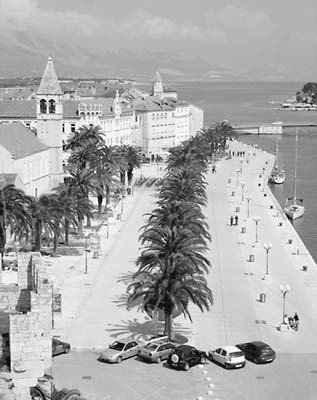
You also have two bus options for reaching Trogir from Split, both roughly the same price (20-25 kn): The faster, easier option is to take a bus from Split’s main bus station, next to the City Harbor. Any bus going north (for example, to Šibenik, Zadar, or even Rijeka) will usually stop at Trogir (1-2/hour, 30 minutes, simply go to ticket window and ask for next bus to Trogir). Note that in the busiest summer months, long-distance bus drivers may not want to take you (preferring to give your seat instead to someone paying for a longer trip). The other, slower option is local bus #37; because this bus makes several stops along the way, it can take longer (3/hour Mon-Fri, 2/hour Sat-Sun; 45-60 minutes, depending on traffic; departs from Split’s suburban bus station—Prigradski Autobusni Kolodvor, a 10-minute walk north of Old Town on Domovinskog rata; buy 20-kn ticket for zone IV at ticket window or on bus). Note that bus #37 also stops at the airport on its way between Split and Trogir; if you’re sleeping in Trogir before catching a flight, this bus is handy (about 10 minutes from Trogir; taxis from Trogir to the airport are exorbitantly priced).
Drivers will find a handy parking lot on the left just before Trogir (10 kn/hour); you can walk into town in five minutes (pass the bus station and cross the bridge).
Trogir is a small island wedged between the mainland and the much bigger Čiovo Island. Busy bridges connect it to the rest of the world at its east end, and a big soccer field squeezed between imposing watchtowers anchors the west end. In the middle is a tight medieval maze of twisty marble-stone lanes.
Tourist Information: At the main square, named for Pope John Paul II (Trg Ivana Pavla II), you’ll find the TI (mid-June-Aug daily 8:00-20:00, Easter-mid-June and Sept daily 8:00-19:00, progressively shorter hours and closed Sun off-season, tel. 021/885-628).
Arrival in Trogir: Buses drop you off at the mainland market, just across the canal from the island. Cross the bridge into town and wander straight ahead for two blocks (bearing left); you’ll run into the main square.
On the main square is the town’s centerpiece, the Cathedral of St. Lawrence (Katedrala Sv. Lovre). Built from the 13th through the 17th century, the cathedral drips with history. The bell tower alone took 200 years to build, leaving it a textbook lesson in Dalmatian architectural styles: straightforward Gothic at the bottom, Venetian Gothic in the middle, and Renaissance at the top. The cathedral’s front entryway—the ornately decorated, recently restored Radovan’s Portal—is worth a gander. Inside, it’s dark, very old-feeling, and packed with altars. The treasury features some beautiful 15th-century carved-wood cabinets filled with ecclesiastical art and gear.
The town’s other sights are the Town Museum (Muzej Grada), a few blocks north (toward the mainland) from the main square; and the Monastery of St. Nikola (Samostan Sv. Nikole), a few blocks south (toward Čiovo Island).
But Trogir isn’t for museum-going; it’s for aimless strolling. And the best place for that is along the wide, beautifully manicured harborfront promenade along the southern edge of town (Obala bana Berislavića). Lined with expensive restaurants, and clogged with giddy, ice-cream-licking tourists, this promenade is the highlight of a visit to Trogir. Often the enormous yachts of the rich and famous stern-tie into the good life here, giving wanderers something to gaze at and yak about. At the far end of the promenade, the Kamerlengo Fortress has a lookout tower with fine views over the town and region.
Some travelers prefer sleepy Trogir to bustling Split. But, since Trogir is also lively after-hours, and is in the airport’s flight path, it’s not the quietest place in Dalmatia.
$$$ Hotel Pašike is a family-run place with lots of character. Situated over a restaurant in the Old Town, its 14 rooms come with over-the-top traditional formality (standard Db-€135/€118/€100, superior Db-€150/€135/€115, less Nov-April, 10 percent cheaper if you pay cash or stay longer than 3 nights, air-con, free guest computer and Wi-Fi, ulica Sinjska, tel. 021/885-185, mobile 091-484-8434, www.hotelpasike.com, info@hotelpasike.com, Buble family).
$$ Hotel Concordia, with 11 outmoded-but-tidy, slightly overpriced rooms at the end of the embankment, is run with warmth by the Bulum family (Sb-€65/€60, small Db with view or bigger Db without view-€80/€75, big Db with view-€100/€90, lower prices are for Sept-June, only partially open in winter, air-con, free Wi-Fi, Obala bana Berislavića 22, tel. 021/885-400, www.concordia-hotel.net, concordia-hotel@st.t-com.hr).
$ Palaća Stafileo, well-run by gentle Thomas, has six apartments in a 15th-century Venetian palace buried in a quiet part of town (Db-€60-70/€55-65/€50-60, price depends on size of apartment, cash only, no breakfast, air-con, lots of stairs, Subićeva 7a, tel. 021/885-680, mobile 098-131-3171, www.trogironline.com/stafileo, stafileo@vip.hr).
$ Hostel Trogir is a basic, bare-bones slumbermill with four dorm rooms on Čiovo Island, a 10-minute walk across the bridge from downtown Trogir (bunk in 6- to 8-bed dorm-€14, air-con, free Wi-Fi, Trg Sv. Jakova 7, mobile 091-579-2190, hosteltrogir@yahoo.com, Marin Rožić).
While Plitvice has Croatia’s best waterfalls, they’re not the only game in town. An hour north of Split, an easy detour off the expressway, is the glittering canyon of Krka National Park. This sprawling park—where the Krka (pronounced KUR-kah) River spreads out and splits into many fingers cut deep into the parched limestone, with shimmering blue waters and forested walls—could occupy a nature lover for days. But its claim to fame is simple to reach and enjoy in just a few hours: the multitiered Skradinski Buk waterfall. It’s impossible to avoid comparisons to Plitvice, so I’ll just give in: While not as magical or as expansive as Plitvice’s cascades, Skradinski Buk is bigger (a single grand run, rather than sprinkled throughout a canyon) and less crowded. And, crucially, at Skradinski Buk, swimmers are allowed to dive into its lowest pool. If you could barely resist the urge to jump into the ponds at Plitvice, this is your chance. (Because the footing is uneven and the services for swimmers are basically nonexistent, I’d recommend this only for hardy paddlers who enjoy a good, rugged swimmin’ hole.)
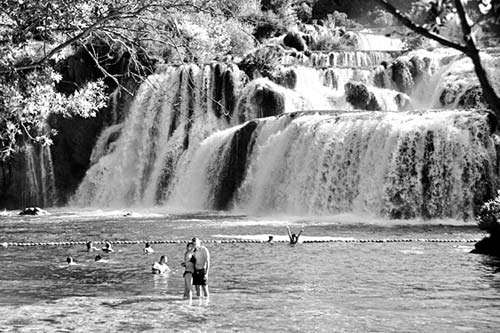
Cost and Hours: The ticket price changes by season—95 kn (June-Sept), 80 kn (March-May and Oct), and 30 kn (Nov-Feb)—and includes the boat from Skradin to Skradinski Buk and the shuttle bus from Lozovac to Skradinski Buk, but not boats or shuttle buses to other parts of the park. The park is open daily June-Aug 8:00-20:00, May and Sept 8:00-18:00, and Oct-April 9:00-16:00. The last boat from Skradinski Buk back to Skradin departs 30 minutes before closing time. Information: www.npkrka.hr, tel. 022/771-688.
Getting There: By car, it’s easy—about an hour north of Split, just off the expressway (see exit information for both major park entrances below). By public transportation, you first have to take a bus to the city of Šibenik; from there, buses go to both the Skradin entrance and the Lozovac entrance. The departure that works best is the 8:00 bus from Split to Šibenik, where you’ll wait about an hour for the 11:15 bus to the park. (Šibenik-Krka buses also depart at 13:00 and 14:00.) The last return bus from Krka to Šibenik departs at 17:00. As always, confirm all of these connections locally. Alternatively, consider paying for an excursion from Split (or other cities in Dalmatia), which includes door-to-door transportation and the park entrance fee; this often doesn’t cost much more than doing it on your own, but you’ll have to stick to a set itinerary.
Visiting the National Park: The national park sprawls over 42 square miles, with five entrances; assuming your interest is the Skradinski Buk waterfall, you can ignore all but two of them. The most efficient entrance for most travelers is the Lozovac entrance (“Šibenik” exit from A-1 expressway, then a 7-mile, 15-minute drive). Here you’ll find a large and free parking lot, and you can take a shuttle bus straight down to the waterfalls (leaves every 15 minutes or so, 10-minute ride on a very twisty and steep road). If you have more time and would prefer to approach the falls by boat, you can use the Skradin entrance (“Skradin” exit from A-1, then a 3-mile, 5-minute drive). From the glassy new visitors center here, you can hop on an hourly boat for the 20-minute trip to Skradinski Buk (included in your park ticket; boats depart every 2 hours off-season, Oct-April).
Skradinski Buk: Once at Skradinski Buk, you’ll find a roughly circular, 1.5-mile boardwalk path that takes you up, down, and around the various cascades, through forests, over gurgling streams, and to a variety of thrilling viewpoints. Near the top of the falls—where the shuttle bus from Lozovac arrives—is a restaurant, an “ethno village” (with a few houses displaying traditional lifestyles), and a large terrace with free WCs and grand views of the falls. Near the bottom of the falls—where the boat from Skradin arrives—is a pay WC popular with swimmers, a large outdoor eating area (mostly table-service restaurants and a few snack stands), and the bridge that cuts across the pool at the bottom of the falls. From this bridge, you’ll spot people enjoying the park’s most popular activity: swimming near the falls.
Swimmers are allowed only in this one, large pool at the bottom of the final cascade. While swimming is permitted, it’s not exactly encouraged; there are no lifeguards, no real beach, no showers, and no official changing rooms (you have several options: wear your swimsuit to the park; pay a small fee to change in the cramped WC 100 yards away from the pool; or awkwardly change into your suit under a towel...or do as many Europeans do, and just skip the towel). When you’re ready to get in, make your way across the uneven, root-embedded ground and find a place to gingerly slip in. The water can be chilly, and you’ll smell the fishy aroma from the pounding spray, but it’s generally clean. As you wade into the pool, watch your footing—the same travertine dams that create those grand waterfalls can be very treacherous to walk on, with uneven surfaces (which can literally vary by several feet from one step to the next), occasional sharp edges, and slippery moss. Once you’ve tiptoed past the initial rocky gauntlet, you can plunge into the deeper section—noticing that the closer you get to the falls, the stronger the current pushes you back.
Other Excursions in the Park: Aside from hiking and swimming, another popular attraction at Krka is its variety of excursions by boat or minibus to farther-flung parts of the park. These excursions are not covered by the entrance ticket. Options include a two-hour cruise to Visovac Island, with its picturesque Franciscan monastery; a 3.5-hour cruise to Visovac Island and Roški Slap (another, less striking waterfall where you can swim); and a 2.5-hour trip to the Krka Monastery and ruins of two fortresses. Other excursions take you to the ancient Roman ruins (amphitheater and military camp) at Burnum.